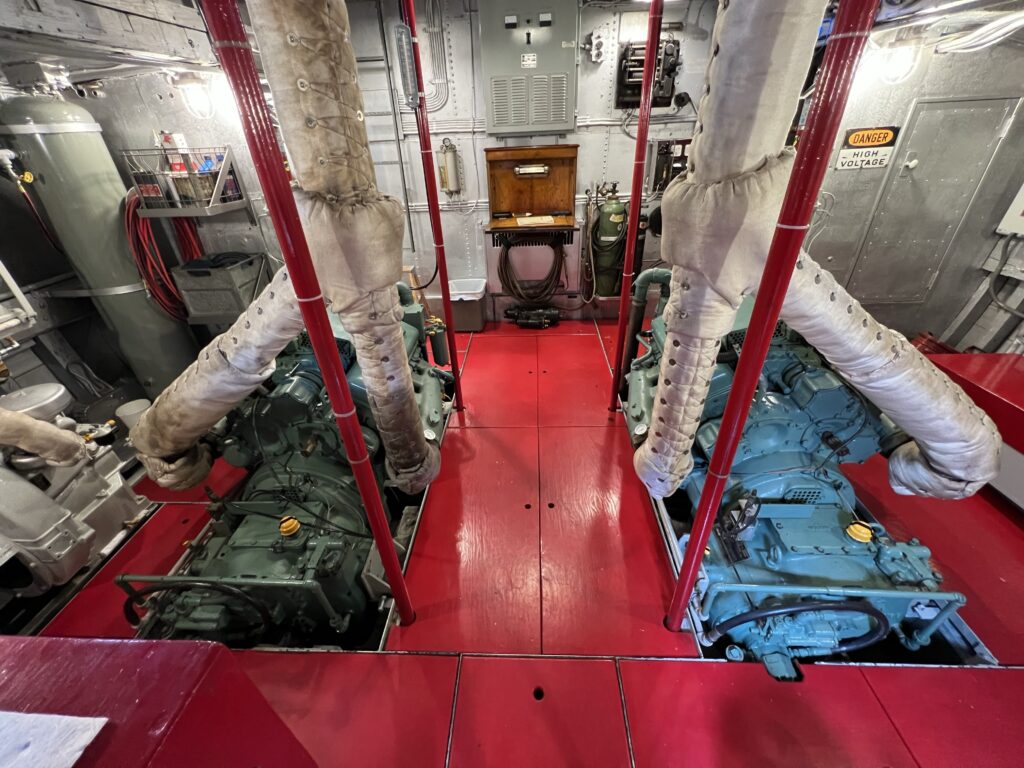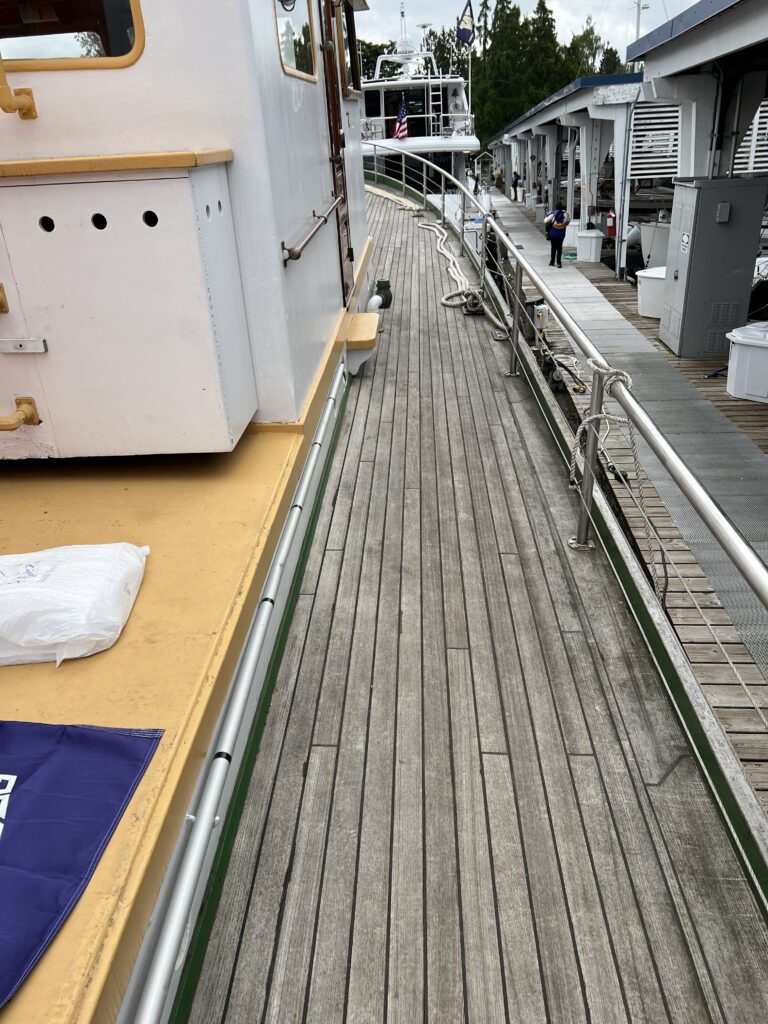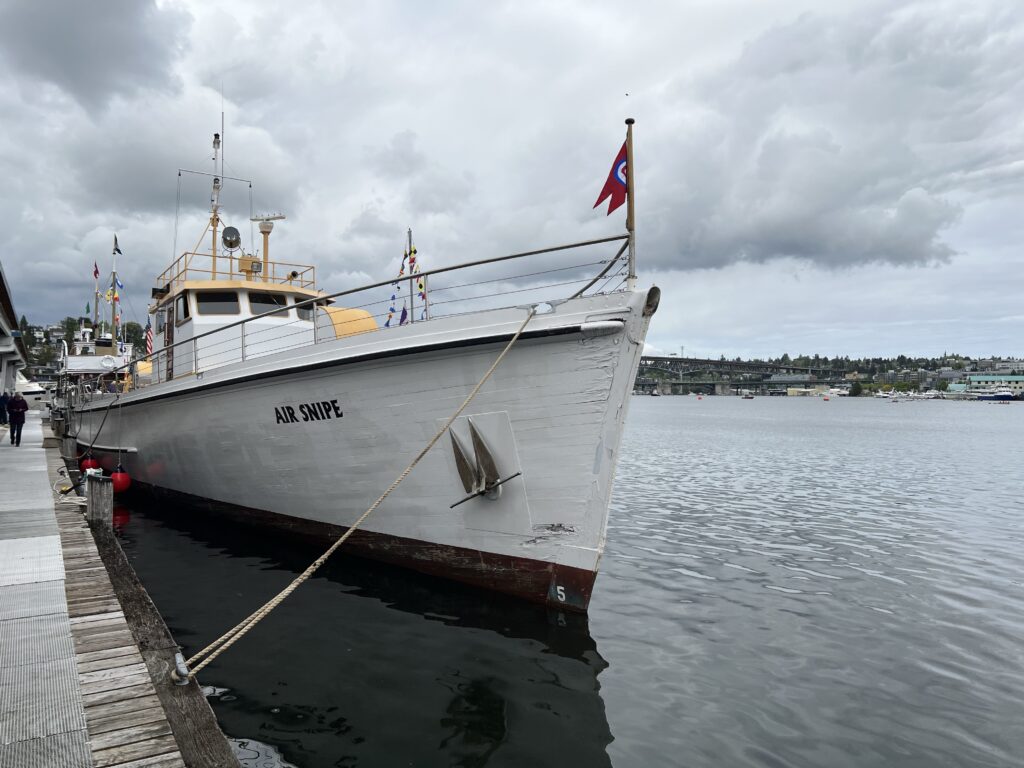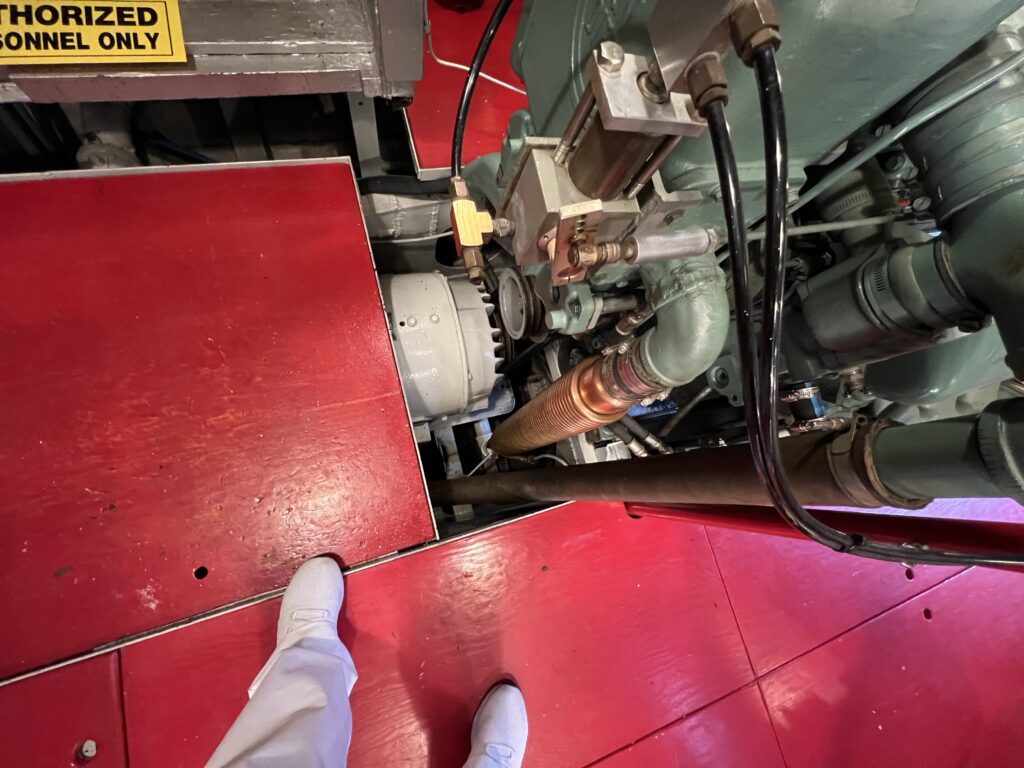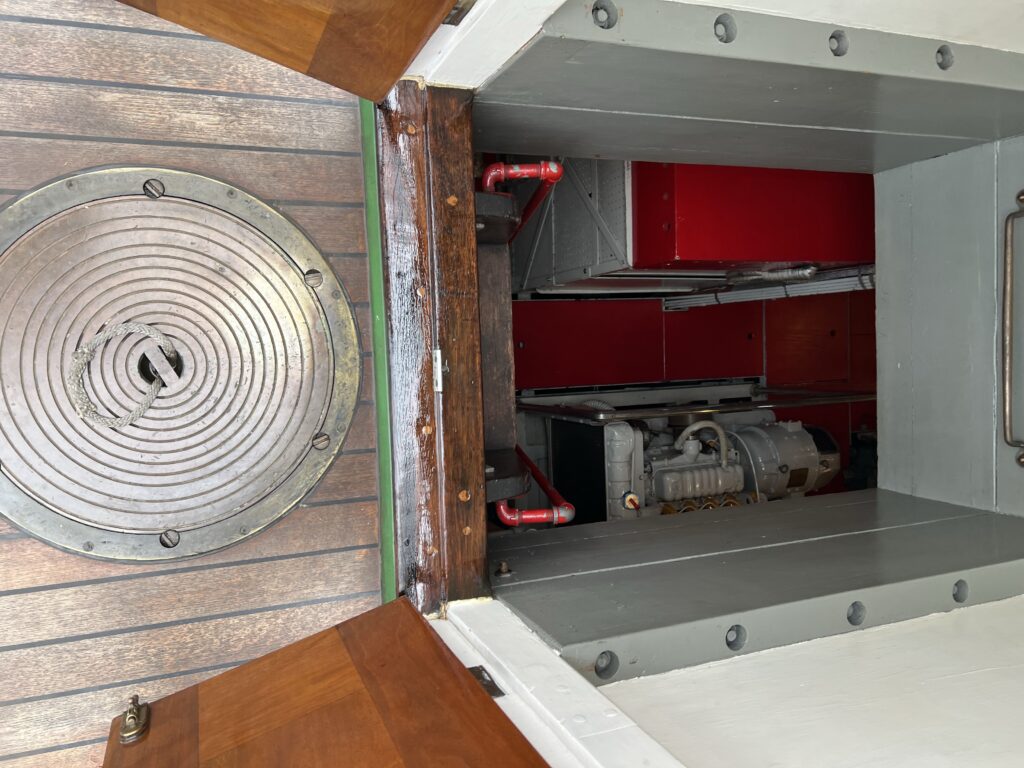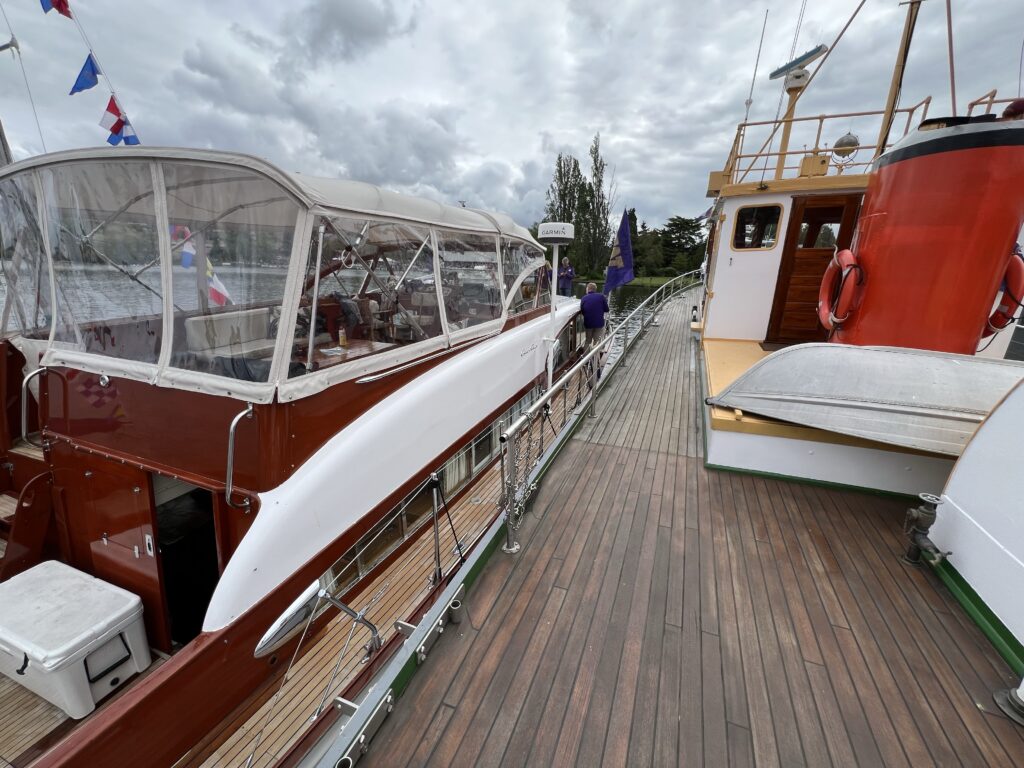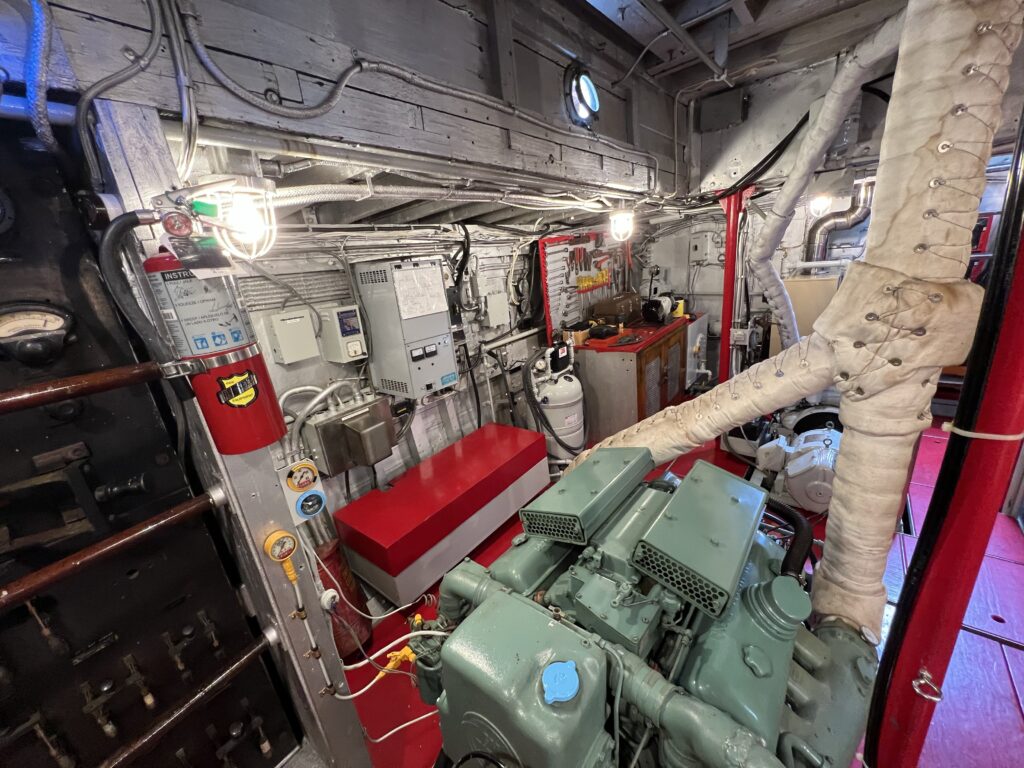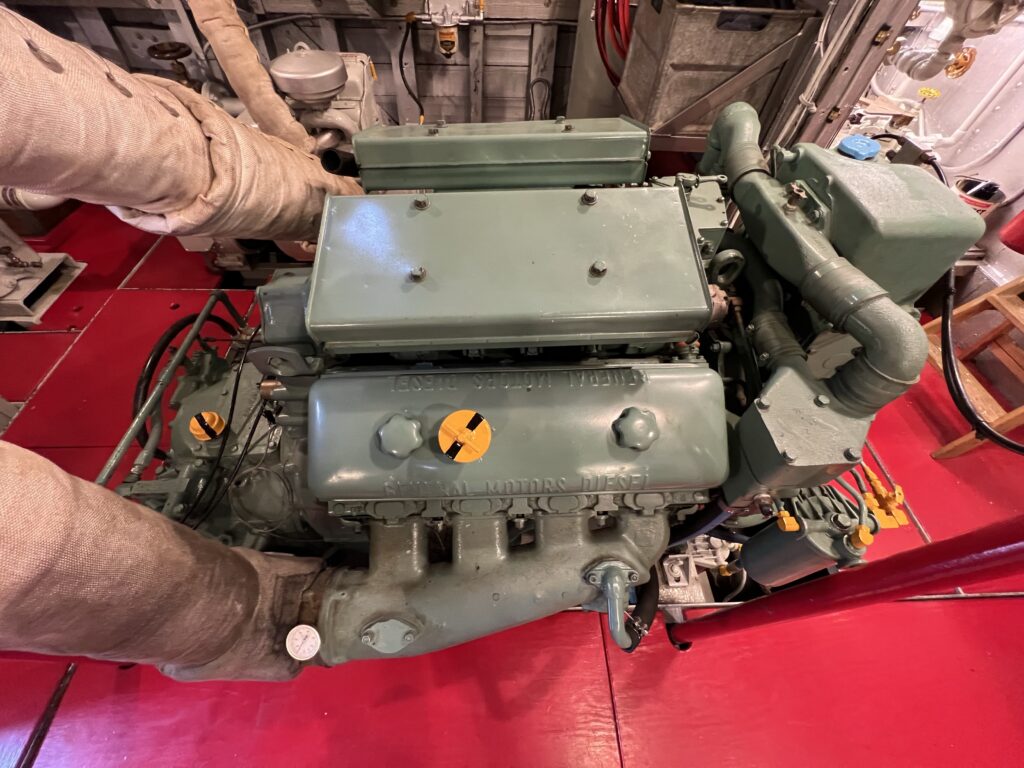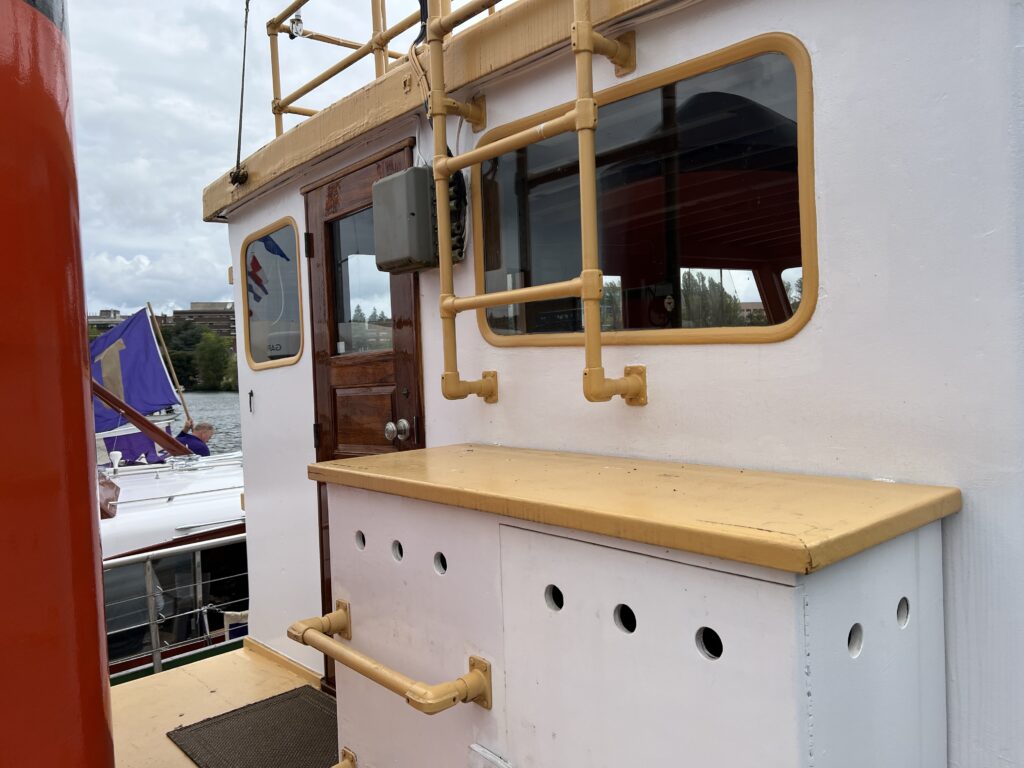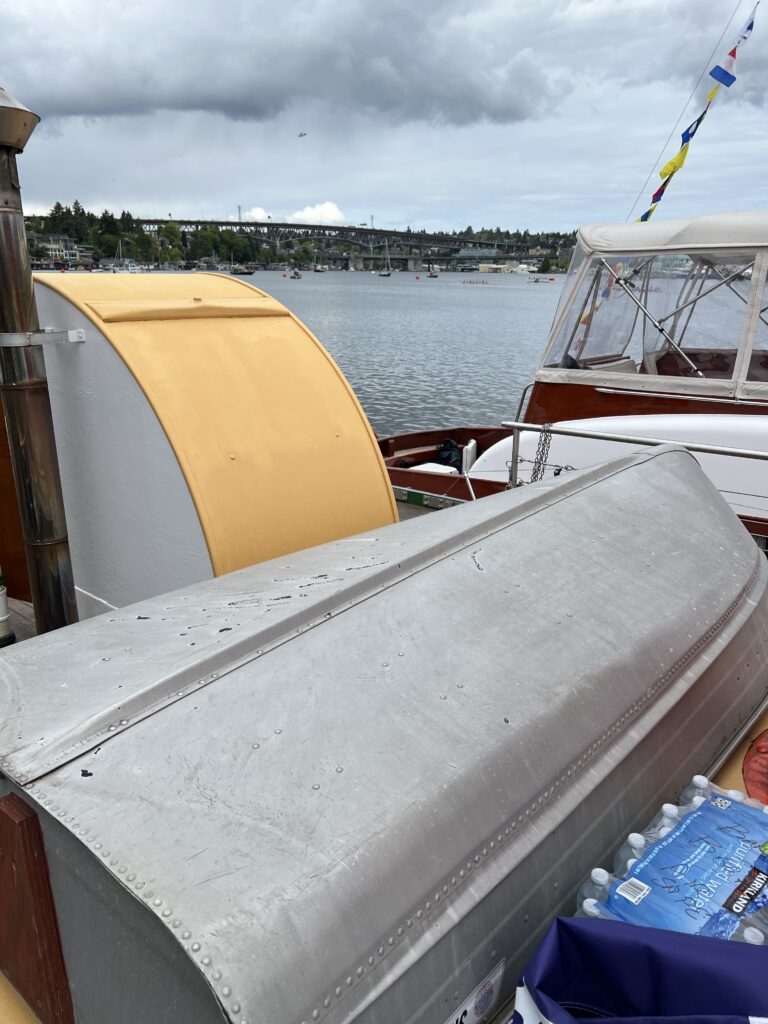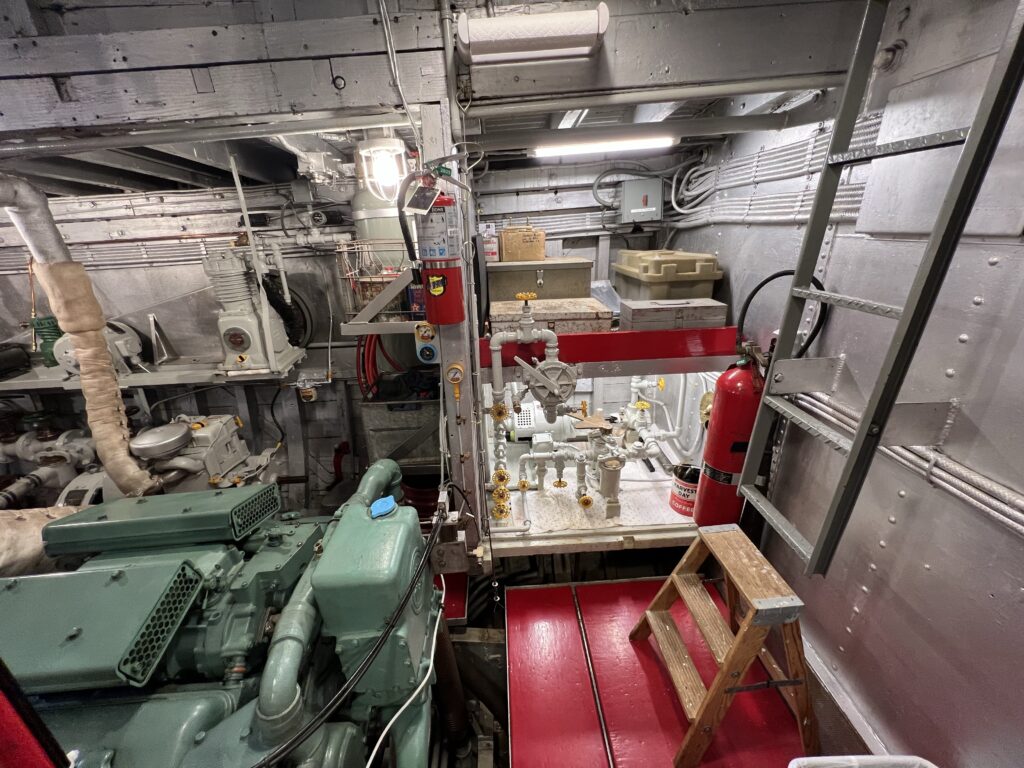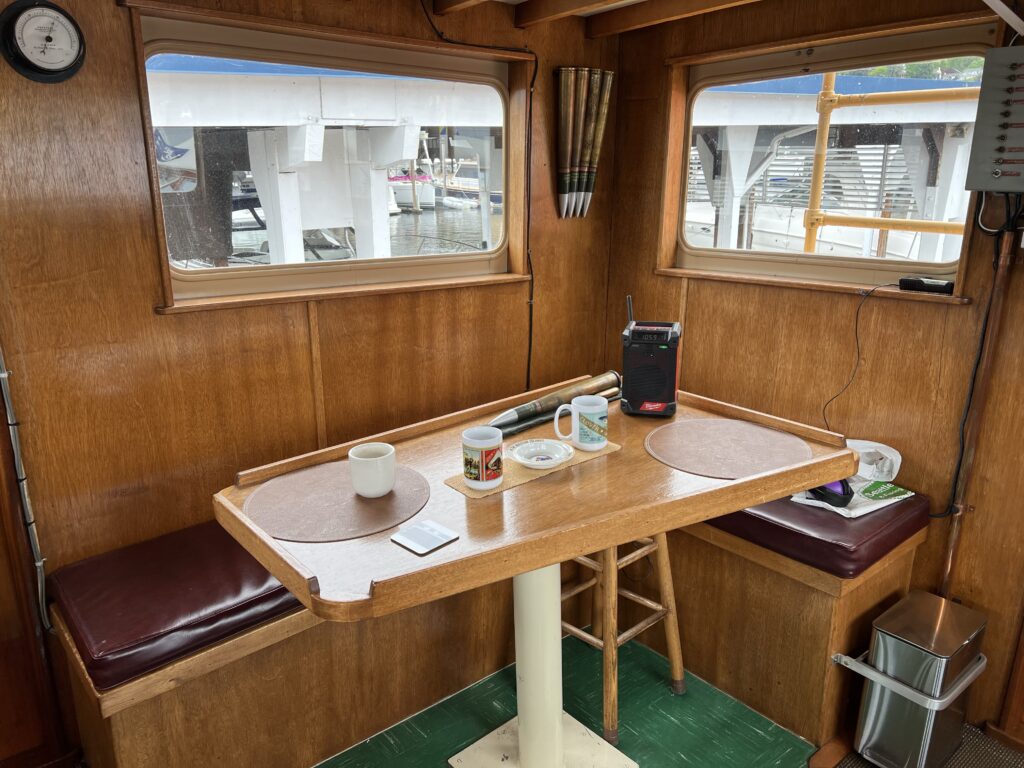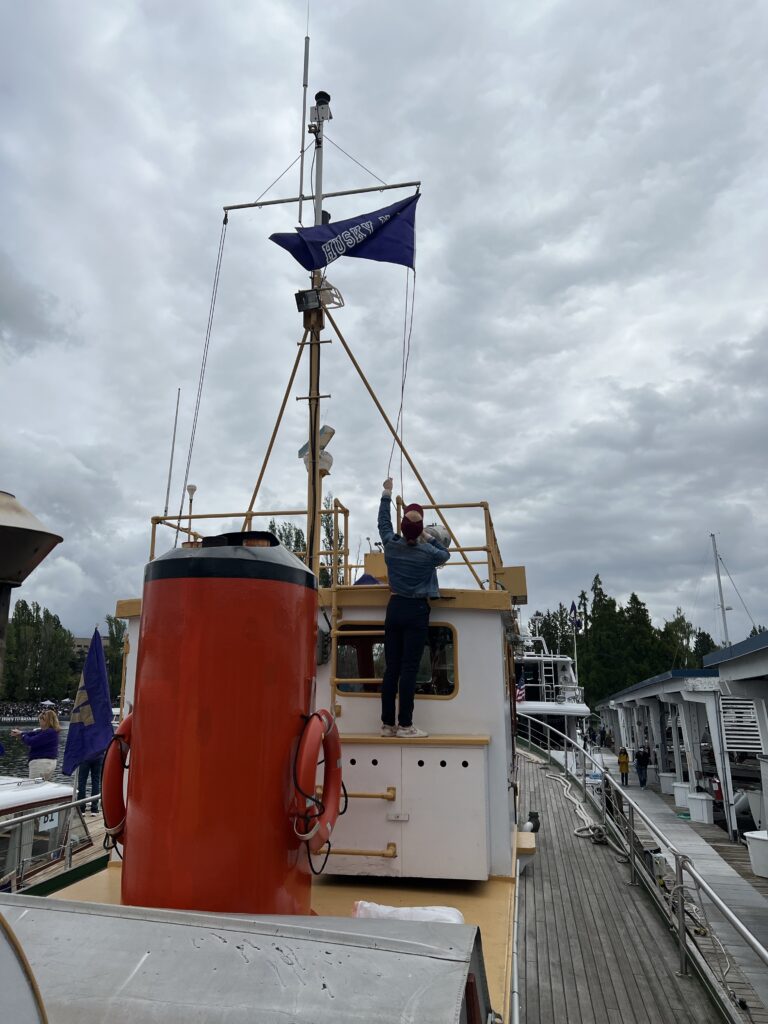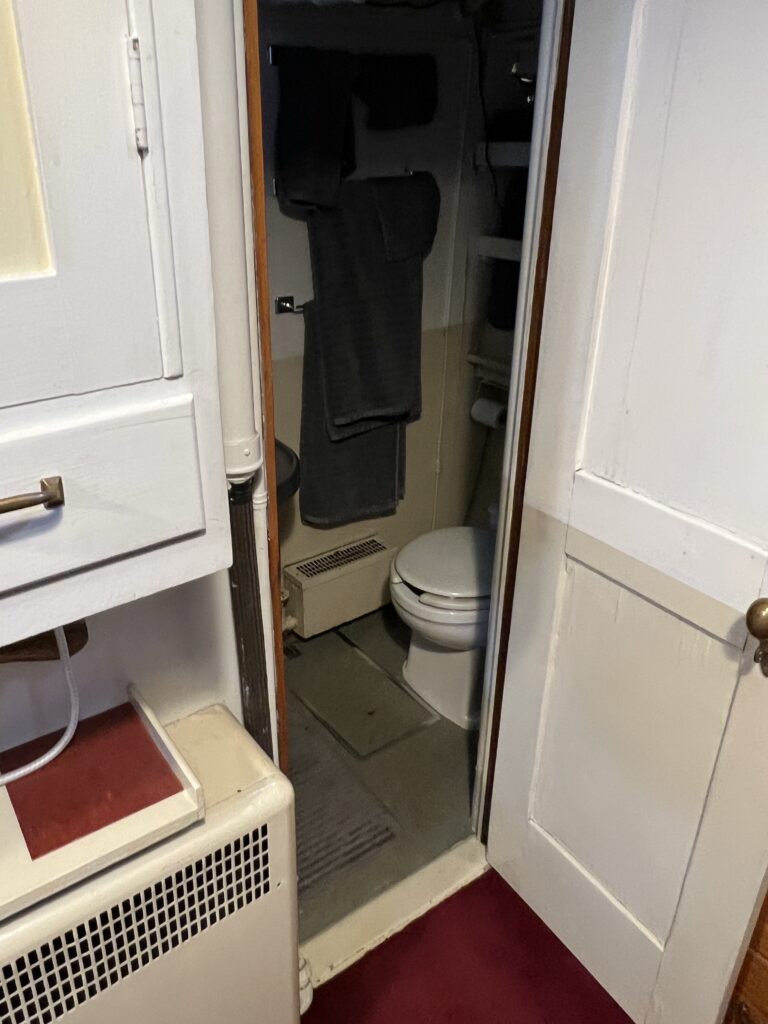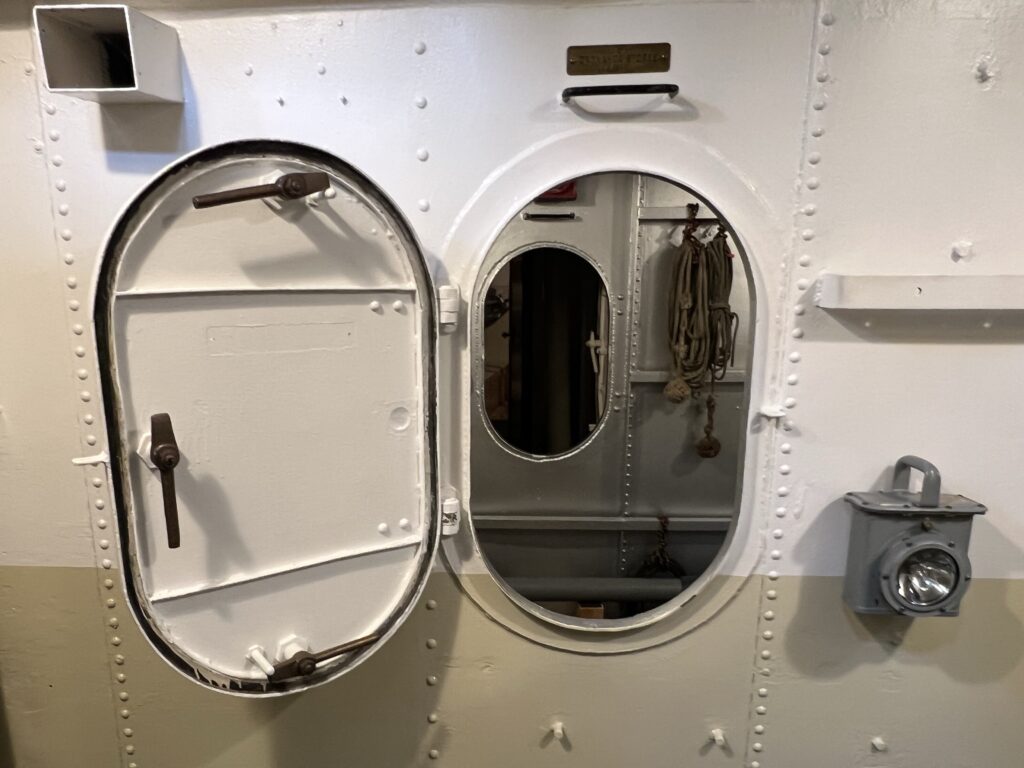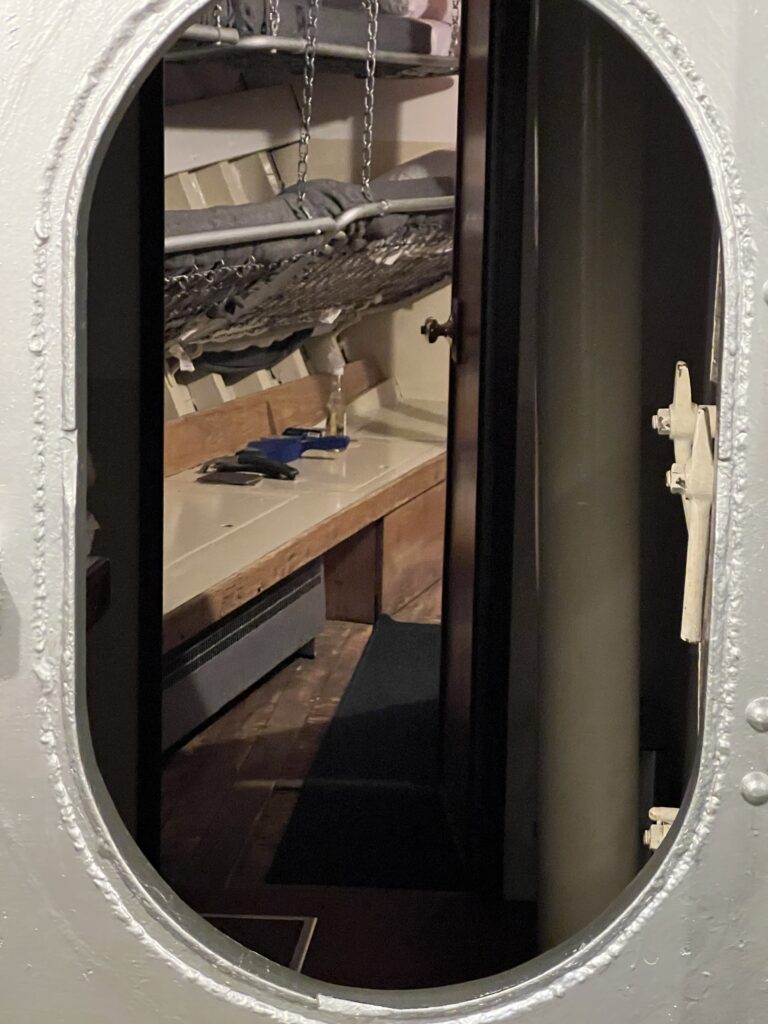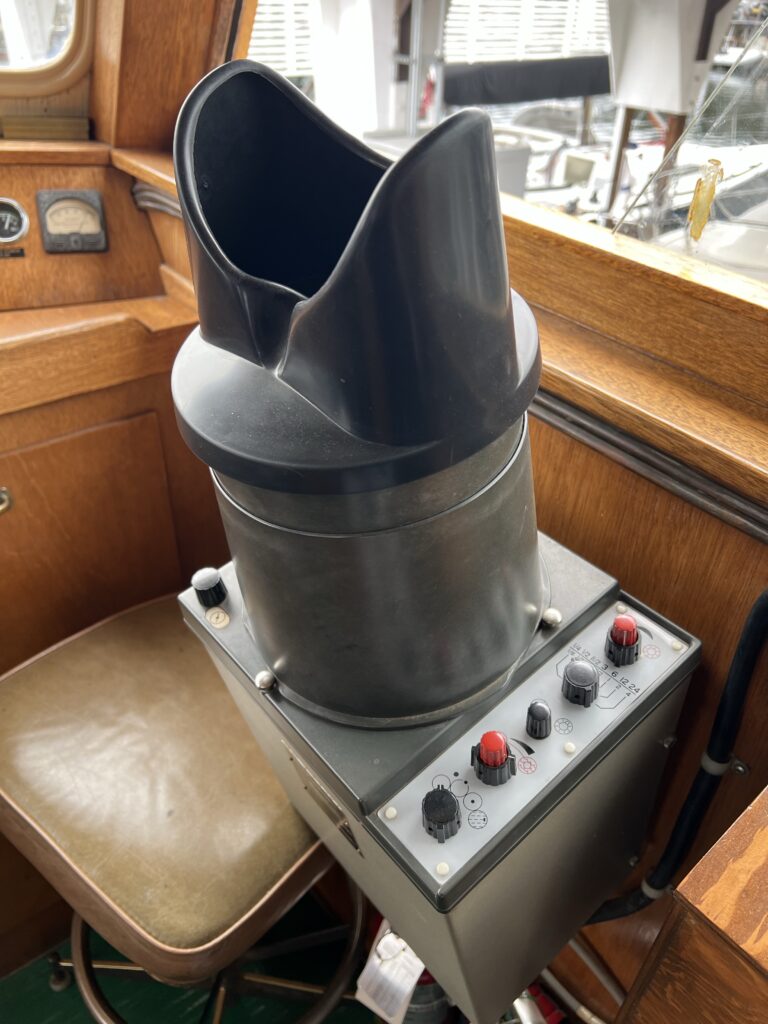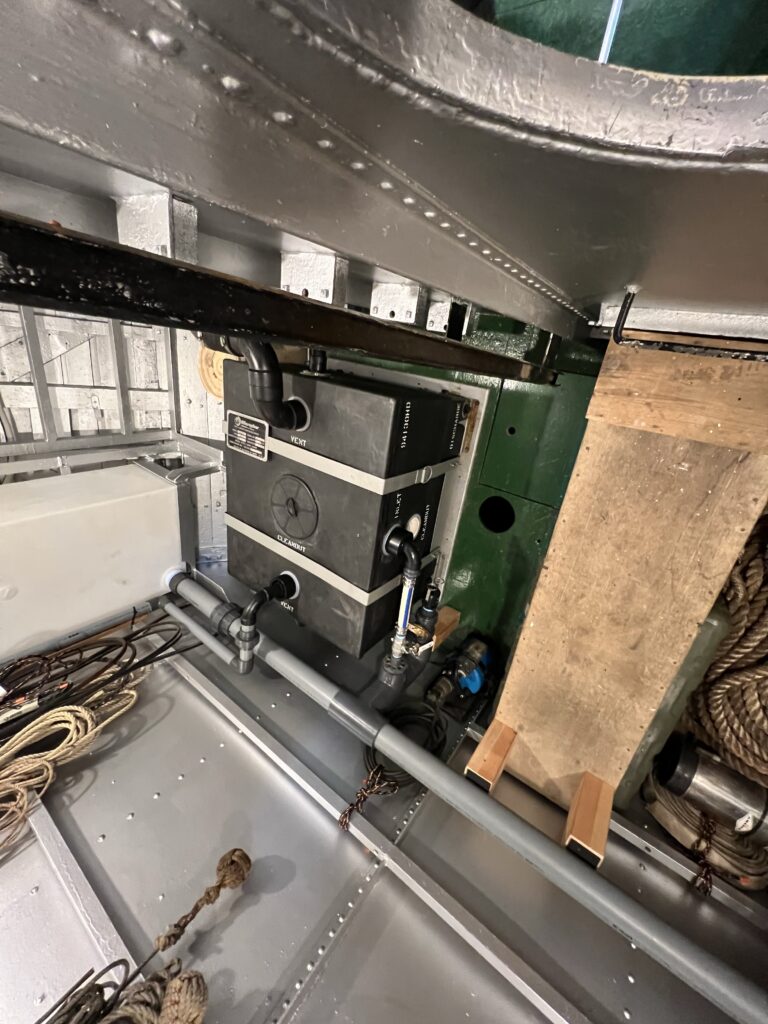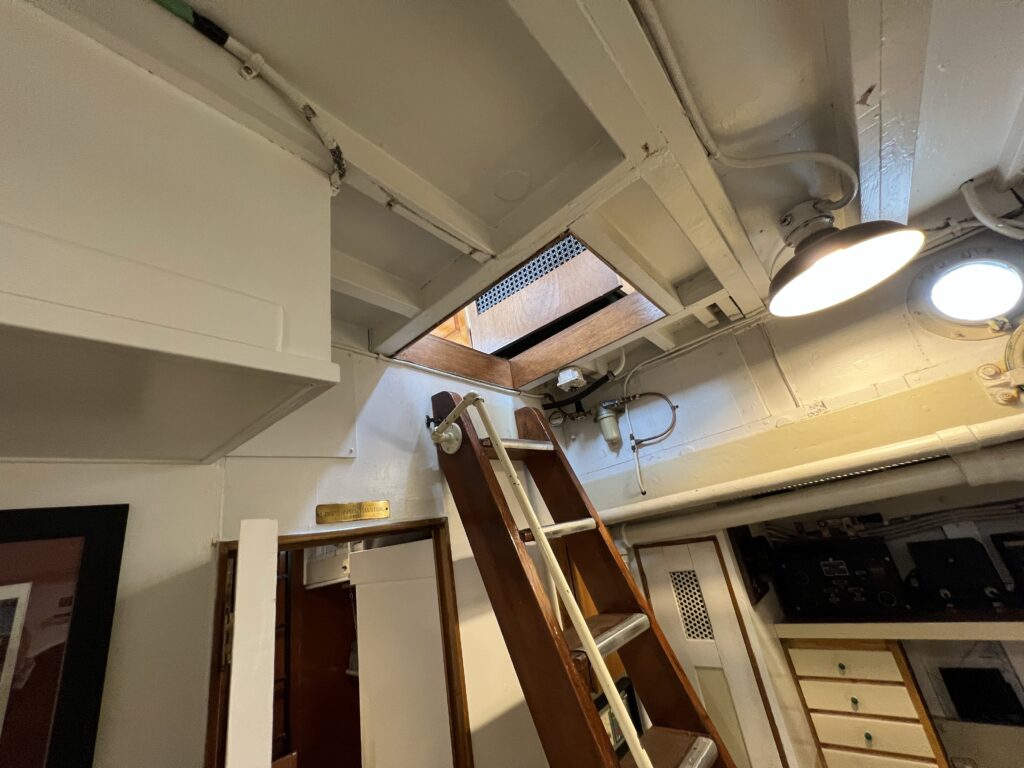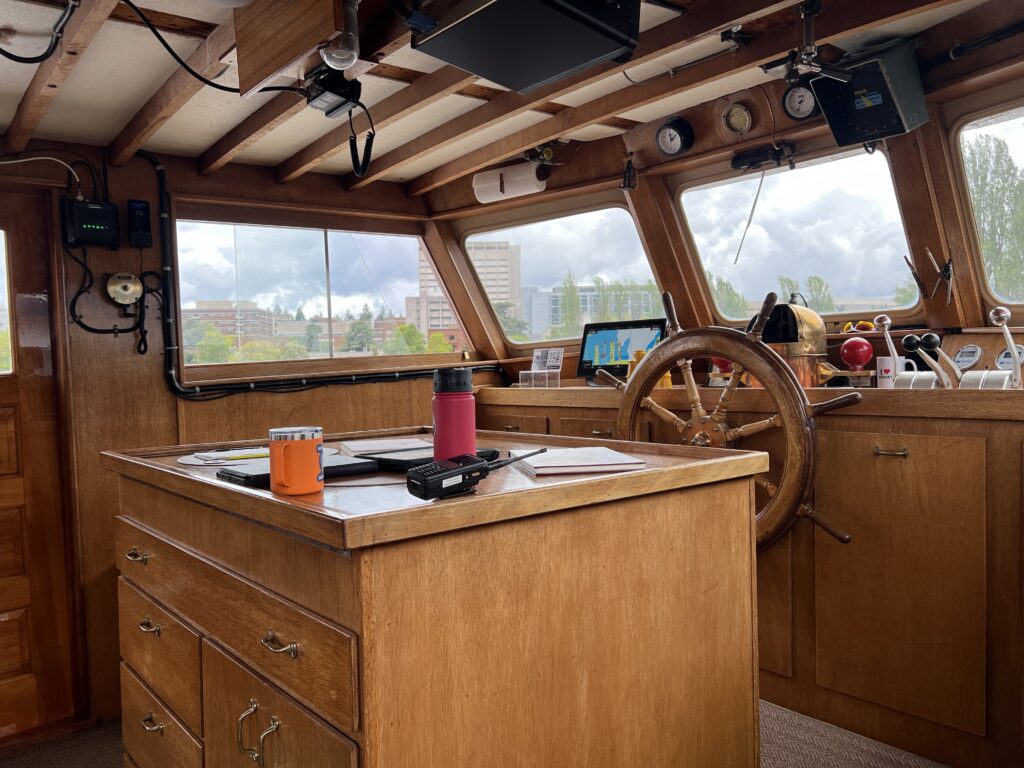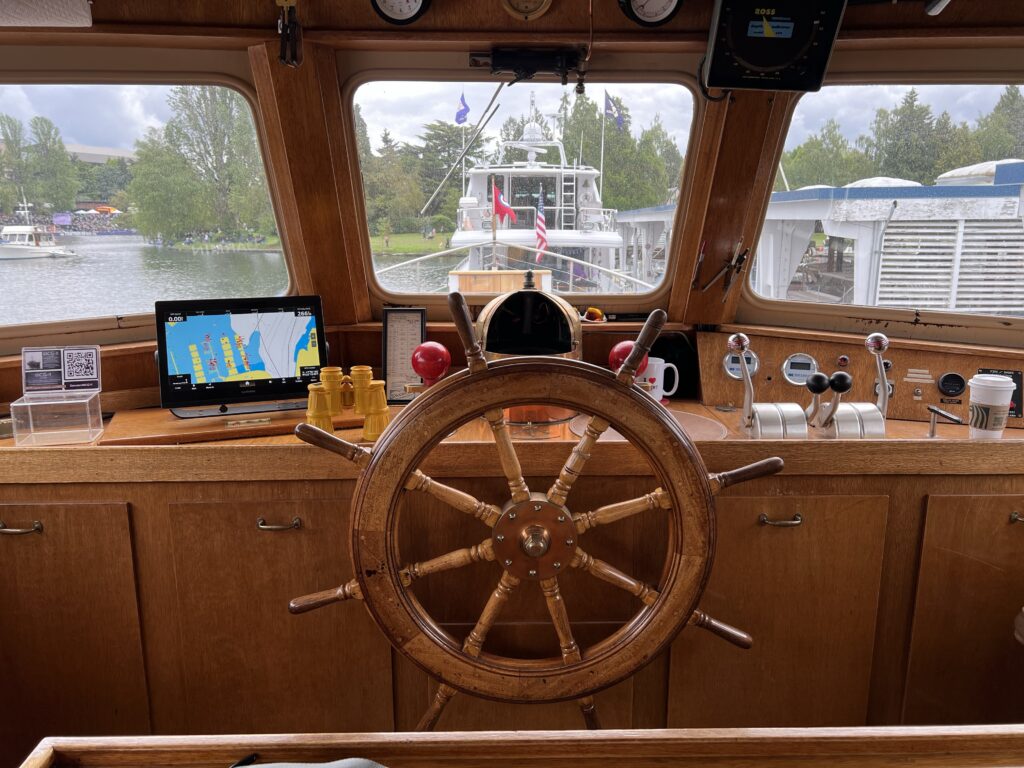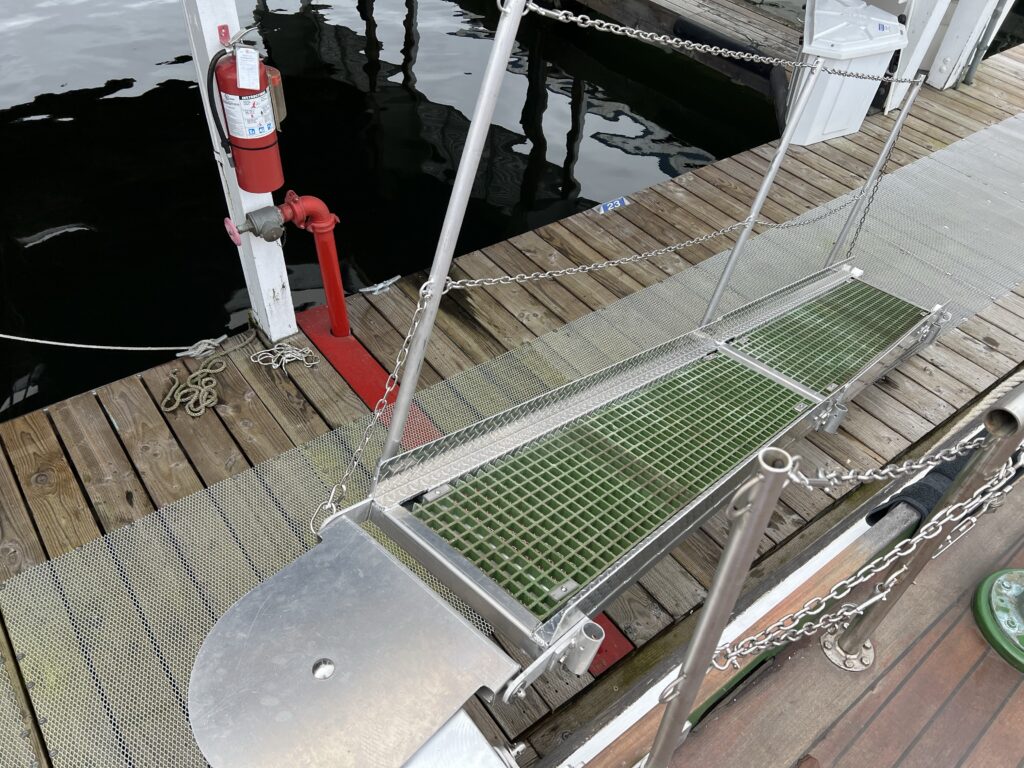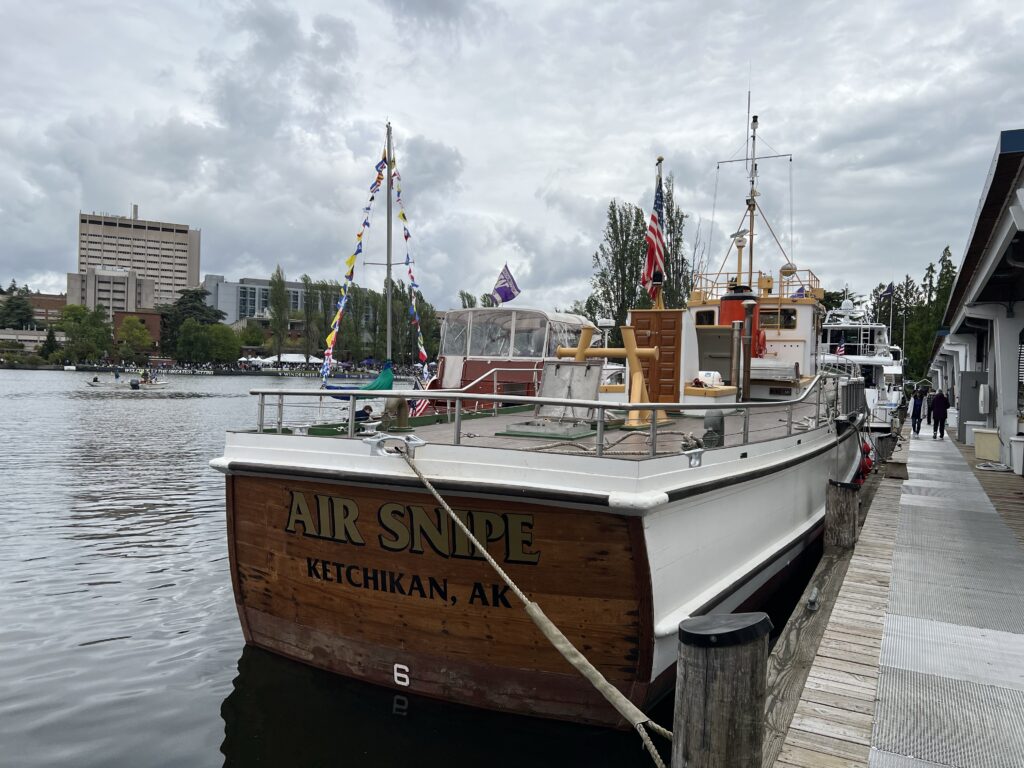AVR stands for “Auxiliary Vessel, Rescue” or “Aircraft Vessel, Rescue,” depending on the source. These boats were part of a small fleet used for rescuing pilots from downed planes, primarily in coastal and intermediate offshore waters.
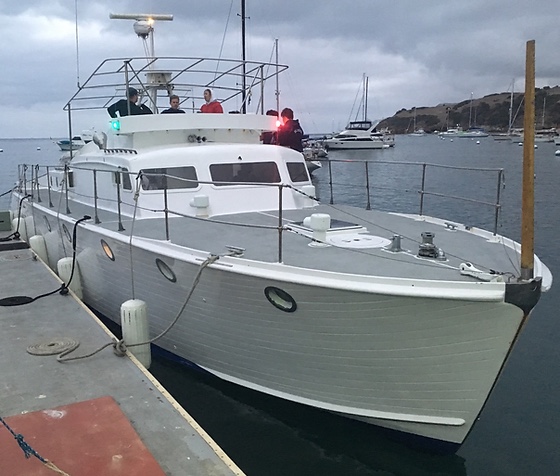
Key points about AVR boats:
- Design and purpose: 63-foot AVRs were designed by Dair N. Long under contract by the USA Navy shortly before World War II. They were built for high-speed rescue operations.
- In 1940 Miami Shipbuilding Corporation (MSC) learned that the Union of South Africa was interested in purchasing rescue boats that the builder would guarantee to make 42 knots. Miami Shipbuilding decided to use four Sea Raiders to get 2000 hp and then rework the Stevens tank data to determine the largest boat that could be built to get 43 knots. The result was the 63-foot Aircraft Rescue Boat (AVR)
- The designation AVR was used for “Auxiliary [or Aircraft, depending on the source], Vessel, Rescue”. Other sources indicate the “V” was the designator for an aviation related vessel, as on aircraft carriers. They were also called crash boats.
- Armament: All AVRs were relatively lightly armed compared to PT boats, typically carrying four .50 caliber machine guns in two tubs. Some crews in the South Pacific Theater added an additional .50 caliber machine gun on the bow for extra firepower.
- Crew and capacity: The 63-foot AVRs carried a crew of eight men and had a capacity for six litters (stretchers).
- The inclusion of two engineers on the 63-foot AVRs was primarily due to the need for manual operation of the engines, including switching gears and managing engine performance. Engineers switched gears when signaled by lights that were controlled on the exterior bridge and interior pilot house.
- Two screws allowed one engine to be put in forward and one in reverse. This made the vessel highly maneuverable for rescuing downed pilots from the water.
- The speed of the 63 footers was controlled from the bridge or pilot house allowing the crew to navigate and adjust speed as needed while the engineers handled the technical and mechanical tasks in the engine room.
- If an engineer noted a problem with one of the engines (such as a fly wheel coming loose) they would shut that engine down and the helmsman would adjust for single engine operation. Typically there would always be an engineer in the engine room.
- Propulsion: Most 63-foot Rescue Boats were powered by two Hall Scott V12 Defender engines.
- The engines were located midships to balance the 63-footer for planing. Exhaust was vented midship. When the vessels were sold to private parties, the exhaust would be vented to the stern to keep the hulls clean. Some private owners would remove the midship engines and put hull speed non planing engines aft.
- Production: A total of 740 63-foot Aircraft Rescue Boats were built, including variants.
- Many AVRs including those operated by the 922nd Quartermaster Company Boat (Aviation), were decommissioned on a massive scale following World War II. The U.S. Air Force finally decommissioned their units in 1956.
- Some AVRs continued to serve in various capacities, including with the Coast Guard and in other nations’ military forces. These boats were often repurposed for different missions, such as towing targets for training exercises or recovering drones.
- Many decommissioned crash boats ended up in private hands, where they were used as yachts, commercial vessels, or by organizations like the Sea Scouts. These boats were often repowered with diesel engines due to the high cost of operating the original gasoline engines.
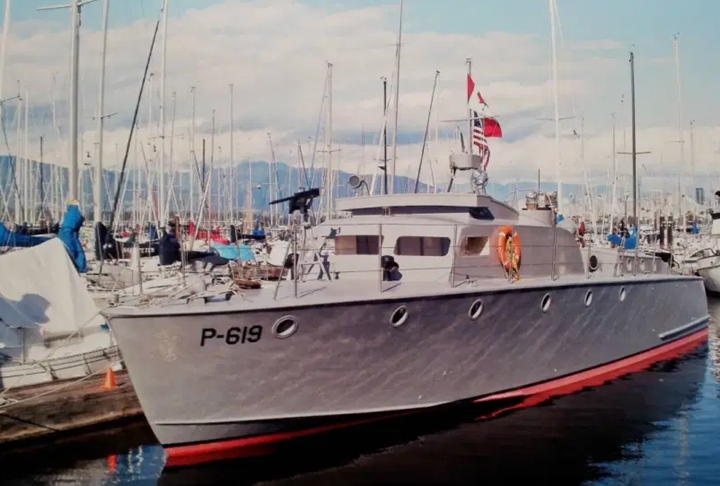
Why wooden construction instead of steel:
- The 63-foot AVRs were designed for speed and maneuverability to quickly rescue downed aircrews. Wooden construction made them lighter and faster than steel hulls.
- Wood was also more readily available as a building material during the wartime production ramp-up compared to steel, which was prioritized for larger military vessels.
- The search results imply wood was used not only to maximize speed but also to simplify mass production of these small rescue craft.
- The term “splinter fleet” referred to the large number of small wooden ships and boats rapidly constructed in the early years of WW2, including submarine chasers, minesweepers, etc.
- The wooden construction and mass production of the 63-foot AVRs would categorize them as part of this “splinter fleet” of auxiliary small craft built for the war effort.
- Wood construction made modifications for repurposing and private use relatively easy.
- All wood construction hulls leak so maintenance is critical for longevity.
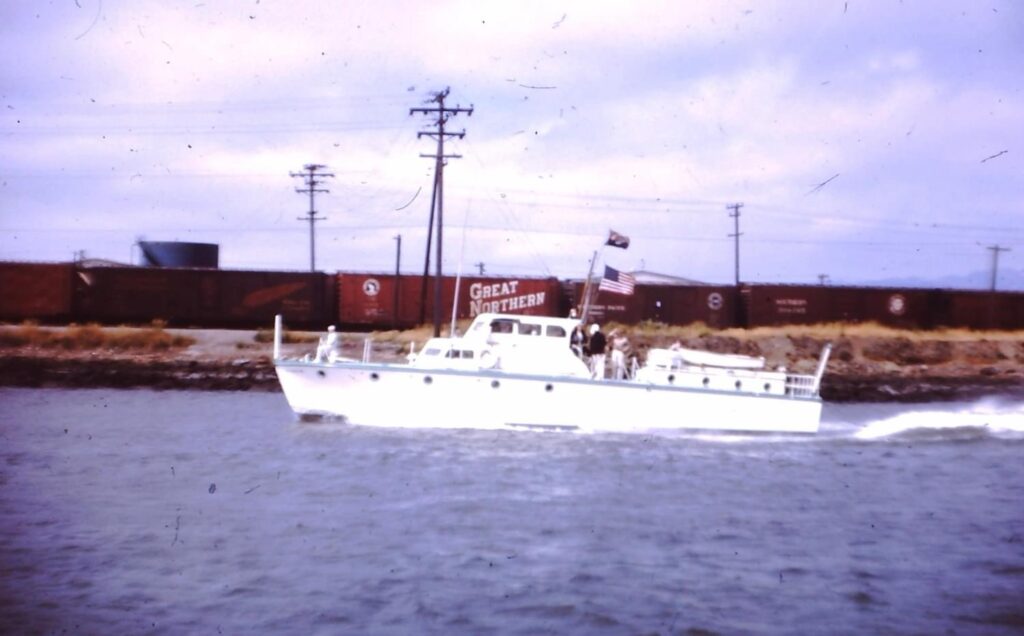
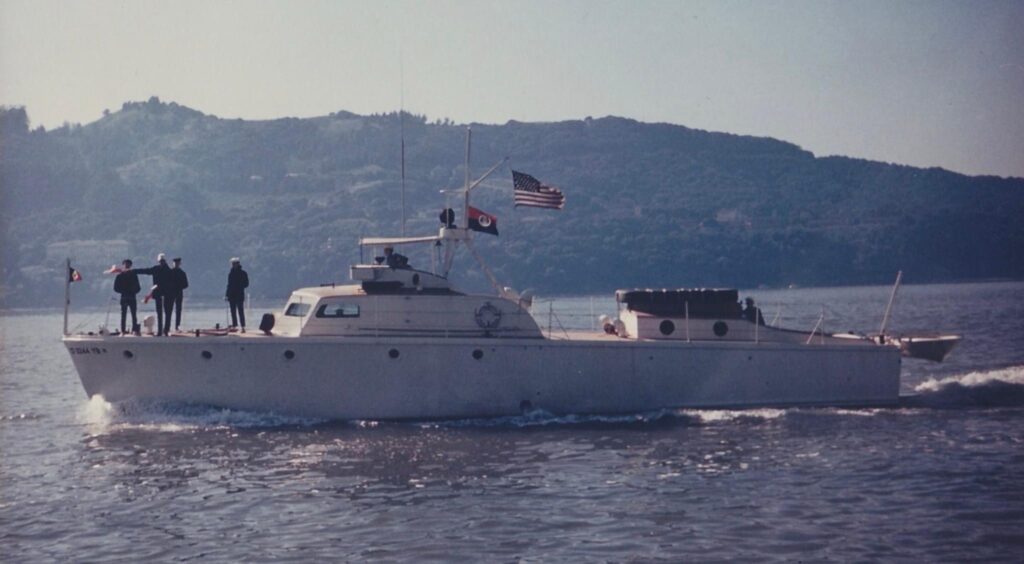
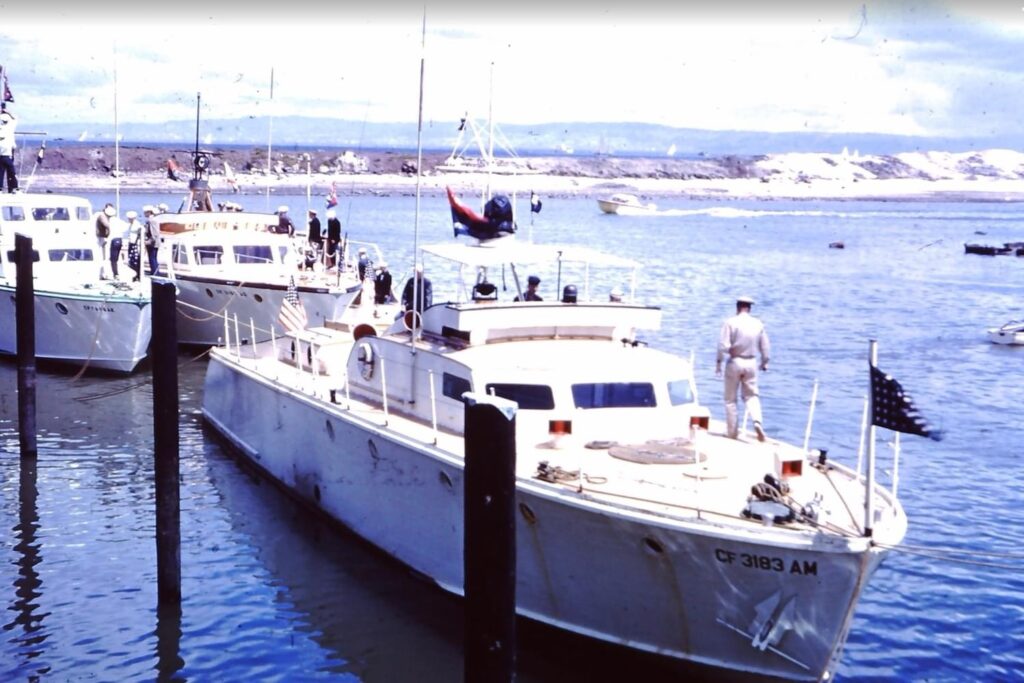
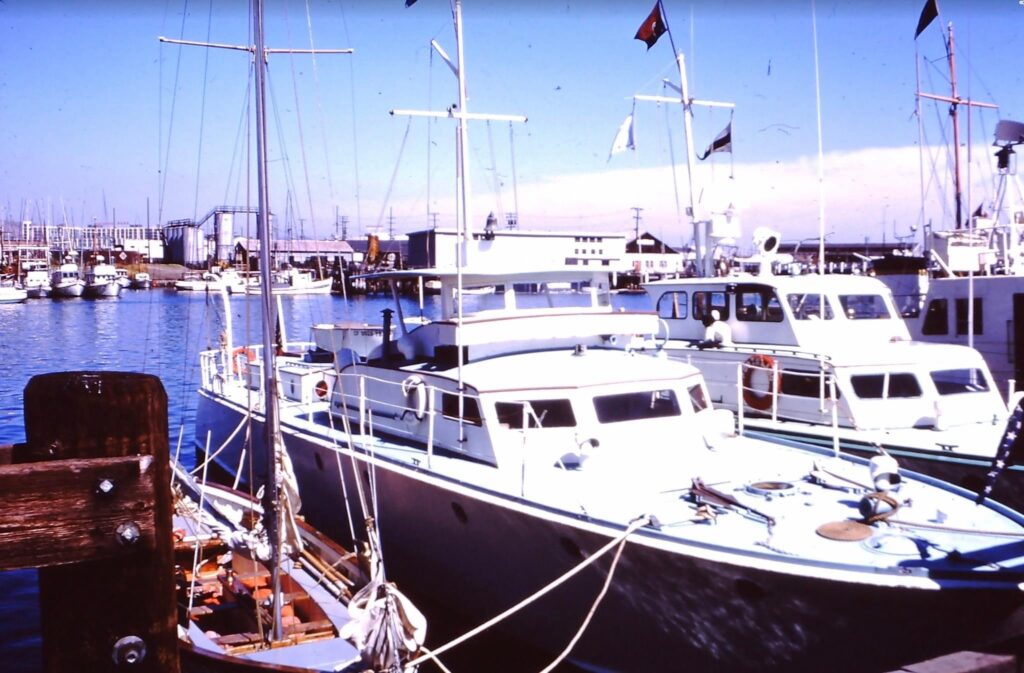
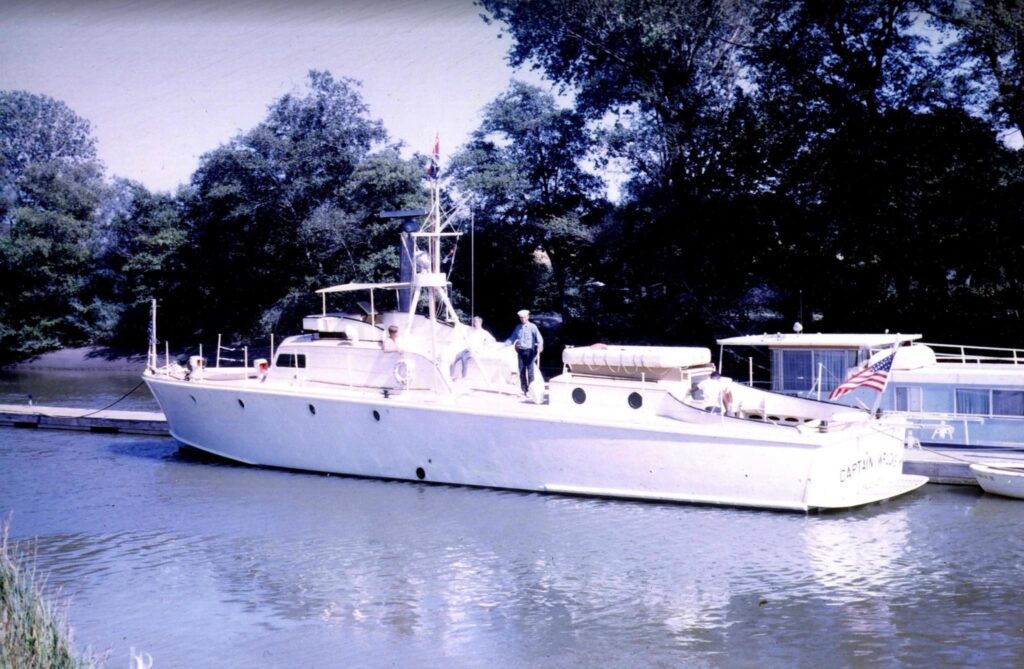
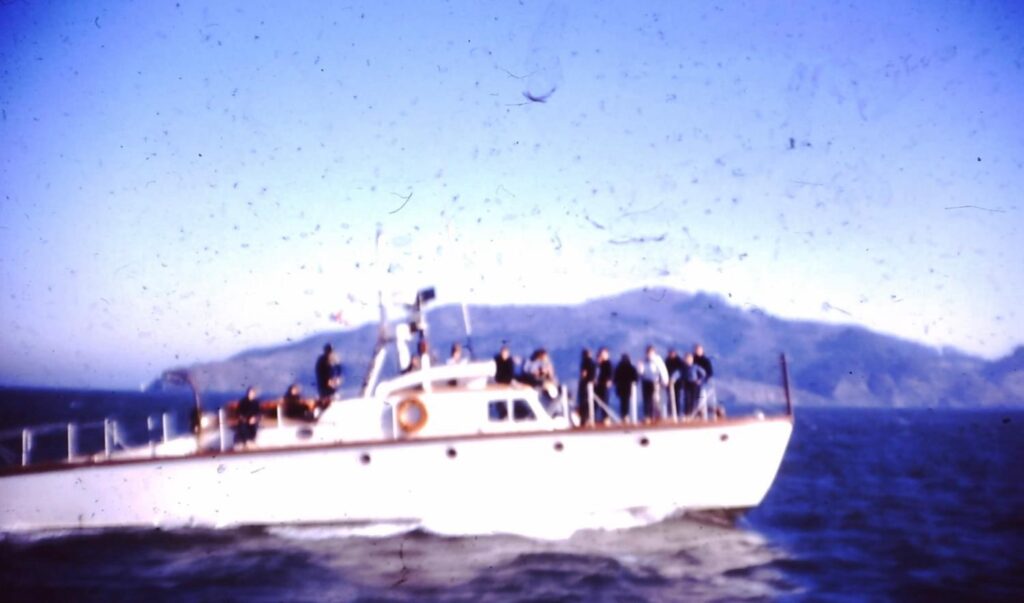
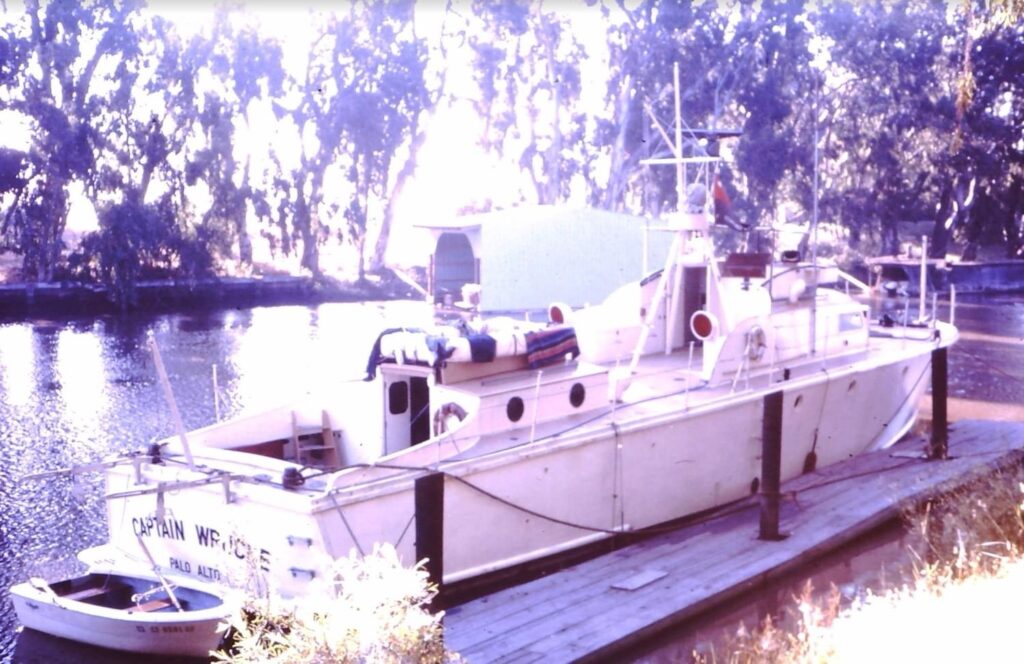
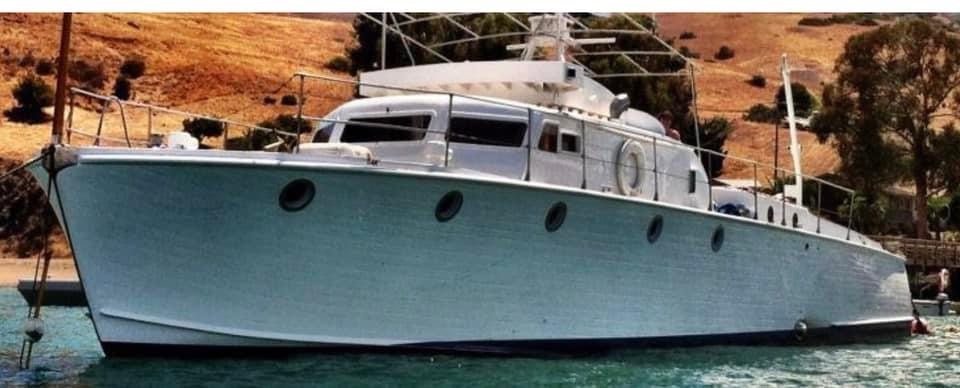
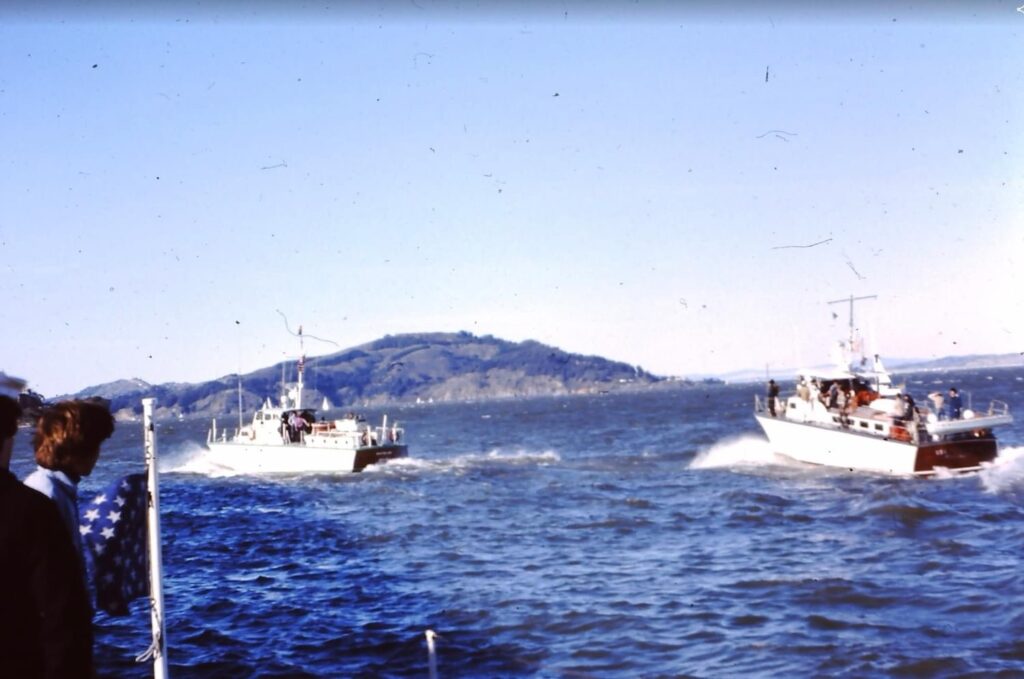
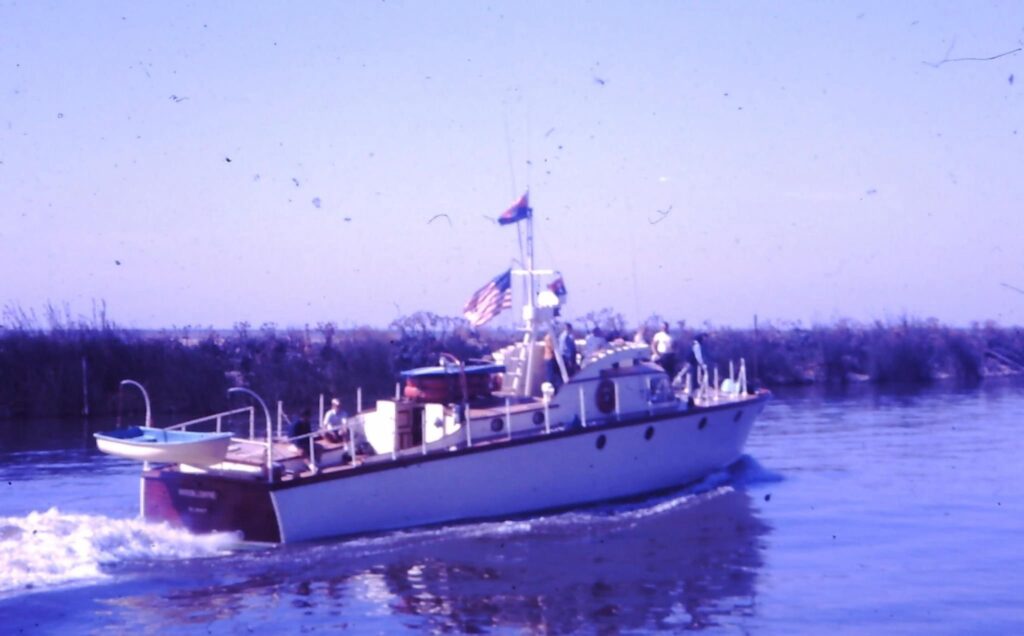
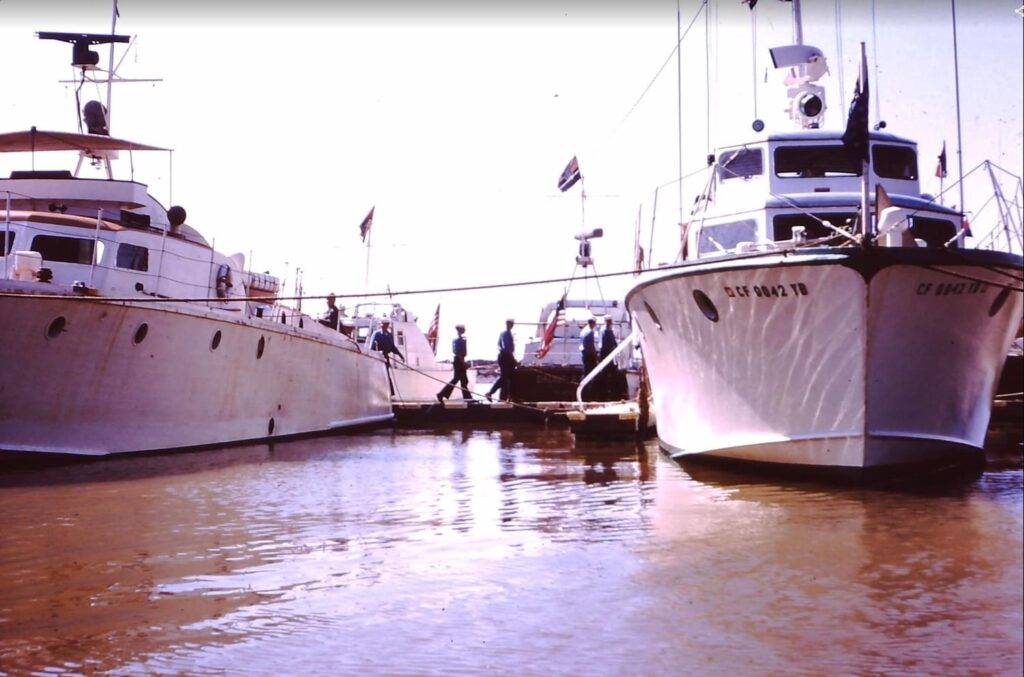
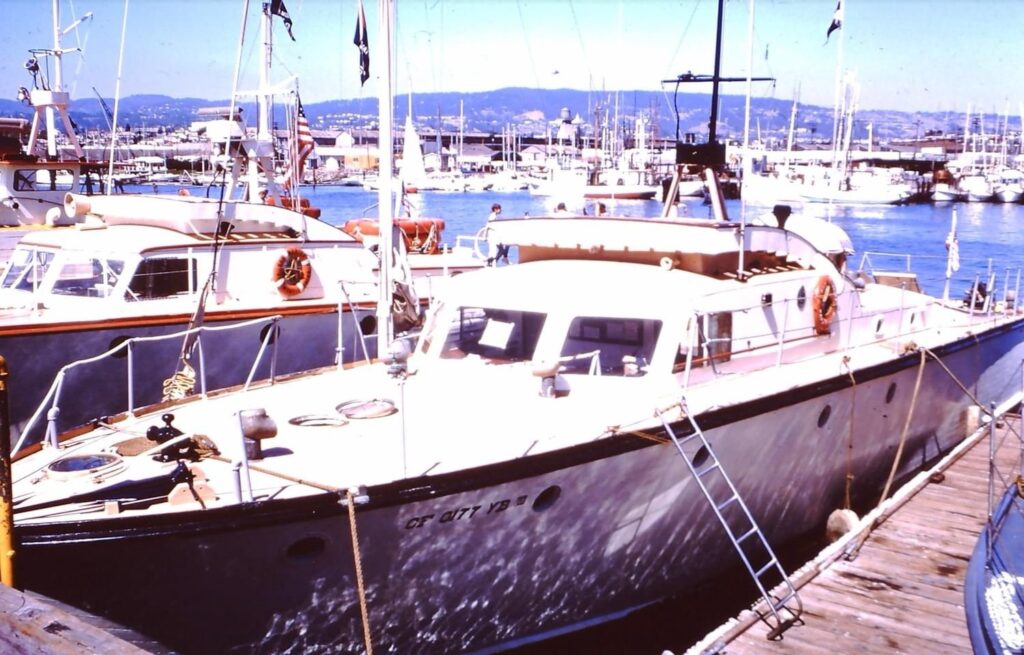
Though wooden warships had been largely supplanted by steel vessels decades earlier, the “splinter fleet” proved that traditional shipbuilding materials still had their place in modern naval warfare when properly applied to suitable mission profiles. Here are some general insights about wooden boat construction from that era, particularly for high-speed craft:
- Hull construction:
- Wooden hulls for high-speed boats were typically constructed using a method called “double diagonal planking” or “double-diagonal construction.”
- This involved two layers of planking laid at opposing 45-degree angles to the keel, creating a strong and rigid structure.
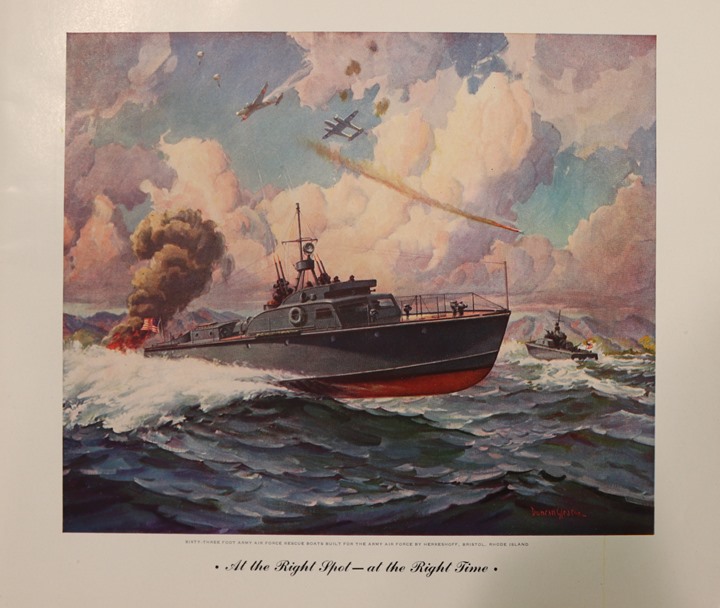
rescue boat in action.
- Wood types:
- Common woods used for high-performance boat hulls in that era included mahogany, oak, and cedar.
- Mahogany was often preferred for its strength, durability, and resistance to rot.
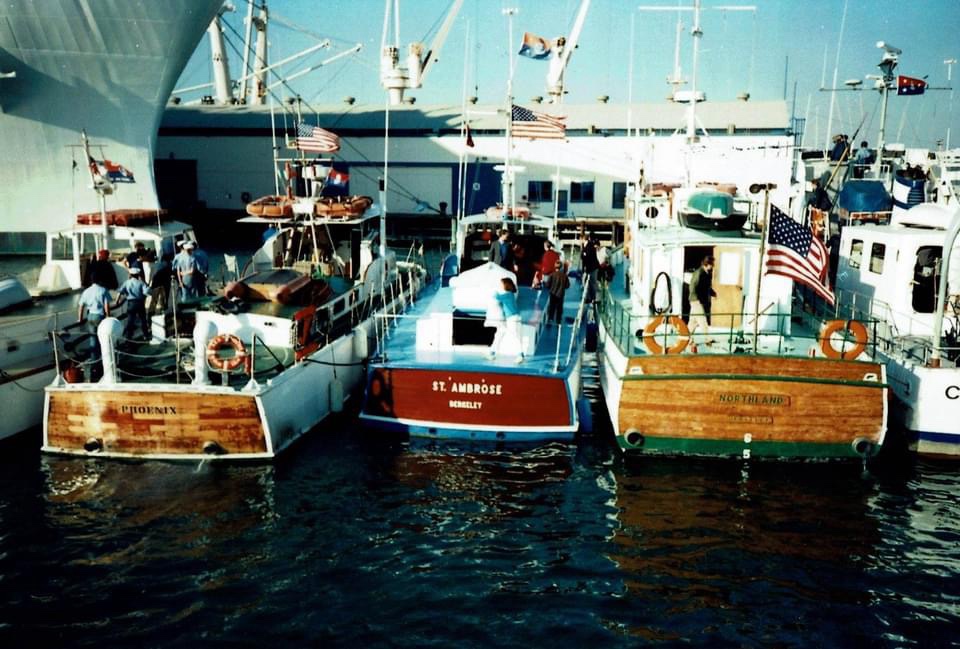
- Stiffening techniques:
- To increase stiffness, longitudinal stringers and transverse frames were used in the hull construction.
- These structural elements helped distribute loads and maintain the hull’s shape during high-speed operation.
- Steel reinforcement:
- The search results don’t mention steel bands specifically for 63-foot AVRs.
- However, some wooden boats of that era did use metal fasteners, bolts, or straps to reinforce critical areas of the hull. And this was done after boats were decommissioned. The SSS (Sea Scout Ship) 63-foot AVR Faralon installed bands to keep the vessel ocean worthy for example.
- Performance over time:
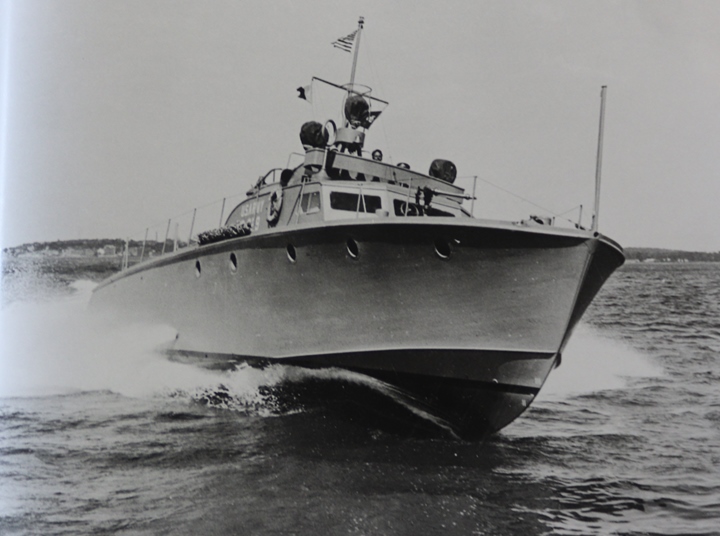
- Wooden hulls flex more over time, potentially affecting planing performance.
- Regular maintenance, including re-caulking and possible re-fastening of planks, was necessary to maintain hull integrity and performance.
- Design considerations:
- The search results mention that Dair N. Long designed the 63-foot AVRs. As an experienced naval architect, he would have incorporated design elements to ensure the hull was stiff enough for high-speed planing.
It’s important to note that without specific documentation about the 63-foot AVR construction, these points are based on general practices for similar boats of that era. The actual construction methods and materials may have varied depending on the specific manufacturer and wartime requirements.
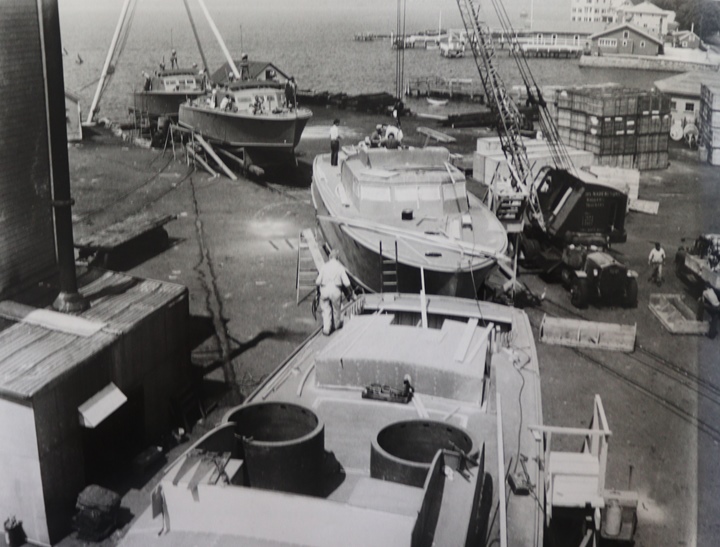
rescue boats between August 1, 1944 and January 8, 1945. This was a delivery rate of more than one a week.
AVRs vs PT Boats
The AVR (Auxiliary Vessel, Rescue) boats were designed and equipped very differently compared to the PT (Patrol Torpedo) boats during World War II.
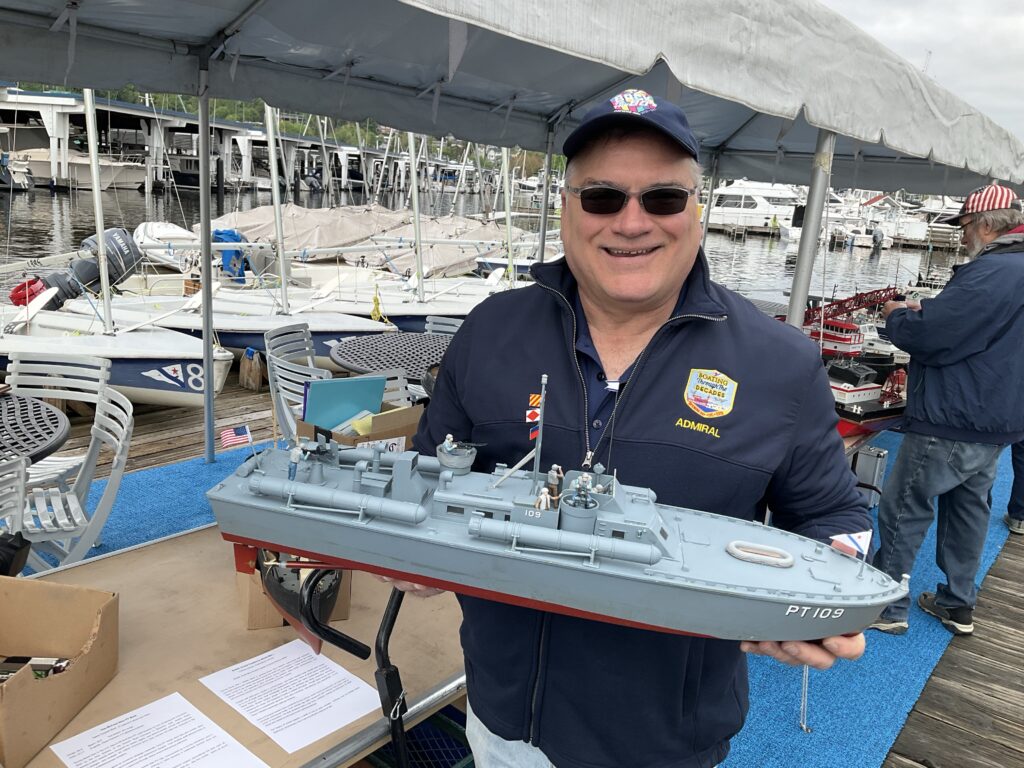
While the PT boats were armed for offensive combat operations, the 740 AVR boats were designed primarily for rescue and support roles. 531 PT boats were built during WWII. Most common were the 80-foot Elco boats, with three Packard V-12 engines, speeds over 40 knots, and a crew of 12–14.
Here are some key differences in their design and capabilities:
PT (Patrol Torpedo) Boats:
- Armed with offensive weapons like machine guns, cannons, and depth charges to attack enemy targets.
- Equipped with offensive and defensive weapon systems to engage enemy forces.
- Designed for high-speed interception and attack missions.
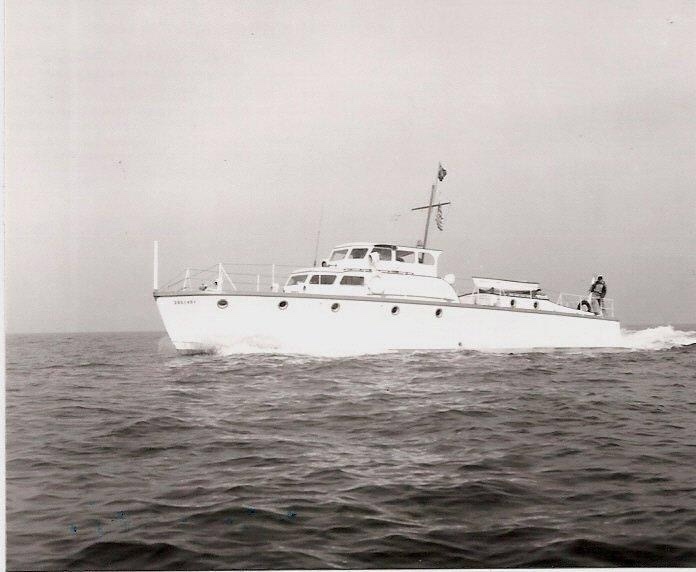
AVR (Auxiliary Vessel, Rescue) Boats:
- Designed and equipped for rescue and support duties.
- Carried life rafts, pumps, and firefighting equipment to assist in rescue operations.
- Did not carry offensive weapons, only defensive capabilities like machine guns to ward off enemy fire.
- Focused on quickly retrieving downed aircrews and damaged aircraft.
The PT boats were built as offensive weapon platforms to attack enemy forces and targets, while the AVR boats were designed and equipped to conduct rescue and support duties, especially recovering downed aircrews and damaged aircraft.
Their roles and design philosophies were completely different, with the PT boats being offensive weapon systems, while the AVR boats were defensive support craft to aid and rescue damaged aircraft and crews.

- Miami Shipbuilding Corporation (formerly Fogel Boat Yard) was a major producer, building 329 boats during the war, including over 200 for allied navies.
- Herreshoff Manufacturing Company built at least 36 63-foot AVRs
- Other manufacturers mentioned include:
- Palmer Scott
- Harbor Boat Building Company – Terminal Island, San Pedro, California
- Fellows & Stewart – San Pedro, California
- Stephens Bros. Boat Builders – Stockton, California
- South Coast Shipyard – Newport, California
- Oxford Boat Company
- Dodge
- Two AVRs were built in Australia

World War II
Based on the information provided in the search results, here are some of the most notable rescues involving 63-foot AVR (Auxiliary Vessel, Rescue) boats during World War II:
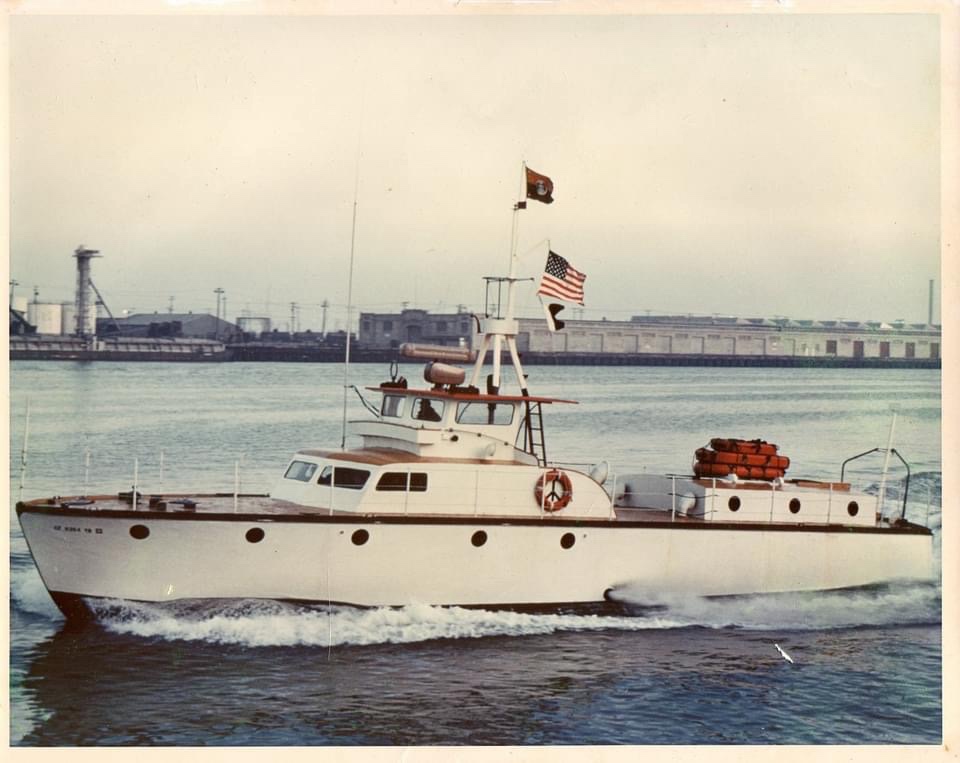
AVR (Auxiliary Vessel, Rescue) boats were stationed at various strategic locations during World War II:
- Gulf of Mexico: AVR 661, an 85-foot crash boat, served in the Gulf of Mexico during World War II.
- Caribbean: Many crash boats were stationed at bases in the Caribbean, including British territories like Bermuda, The Bahamas, St. Lucia, Jamaica, Trinidad, Antigua, and British Guiana. These bases were established as part of the destroyers-for-bases deal with Britain.
- East Coast of the United States: Crash boats protected vital shipping lanes along the east coast.
- South Pacific: Many of the 104-foot boats served in the South Pacific, supporting island-hopping campaigns.
- West Coast of the United States: 63-foot AVRs were stationed on the West Coast to support the vast aircraft training centers.
- Tyndall Air Force Base, Florida: Although this was post-war, it indicates that some AVRs were stationed at coastal air bases.
- Overseas Allied Bases: Some AVRs were transferred to allies under Lend-Lease agreements, including Great Britain, South Africa, and the Soviet Union.
- Pacific Theater: Many crash boats (Air Sea Rescue Boats) were used across the vast South Pacific, primarily supporting island-hopping campaigns.
- Offshore Locations: Some crash boats operated from tender ships that would refuel and restock boats not stationed at harbors, allowing them to operate far from shore.
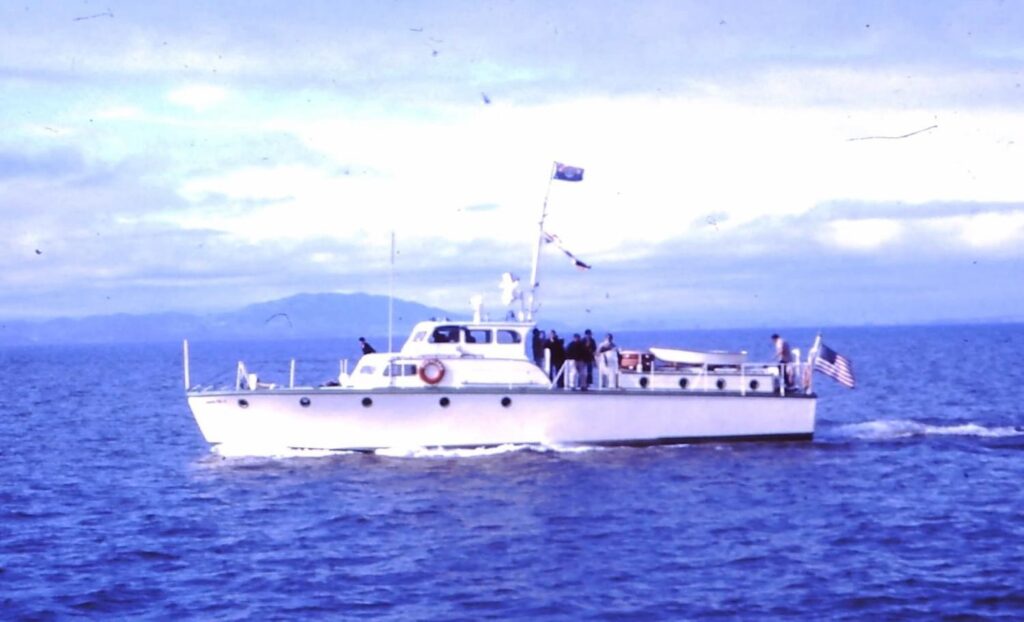
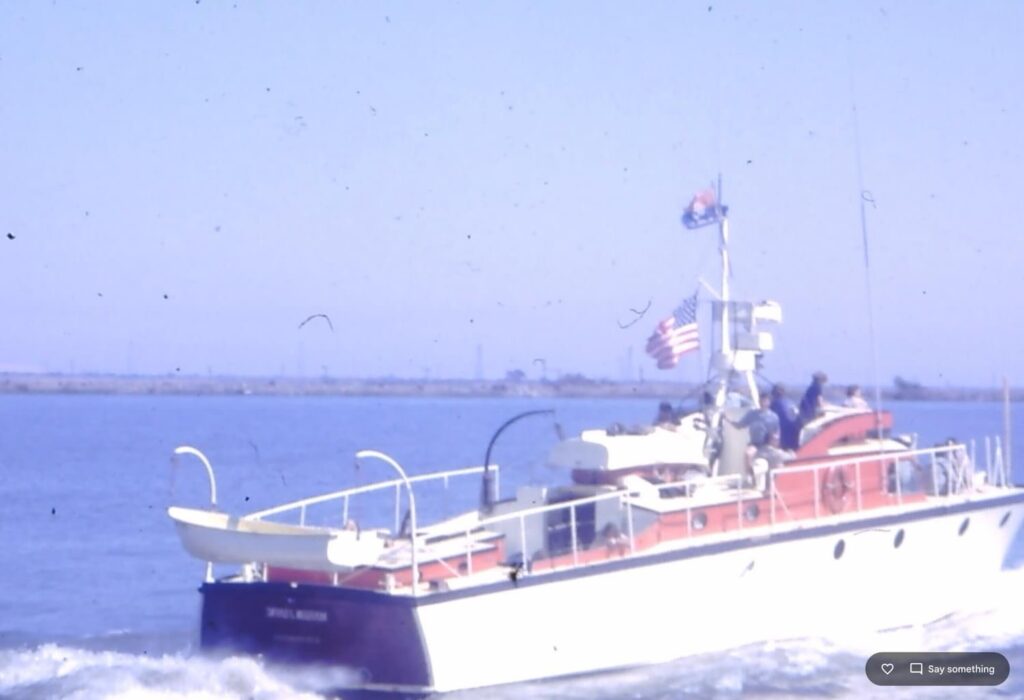
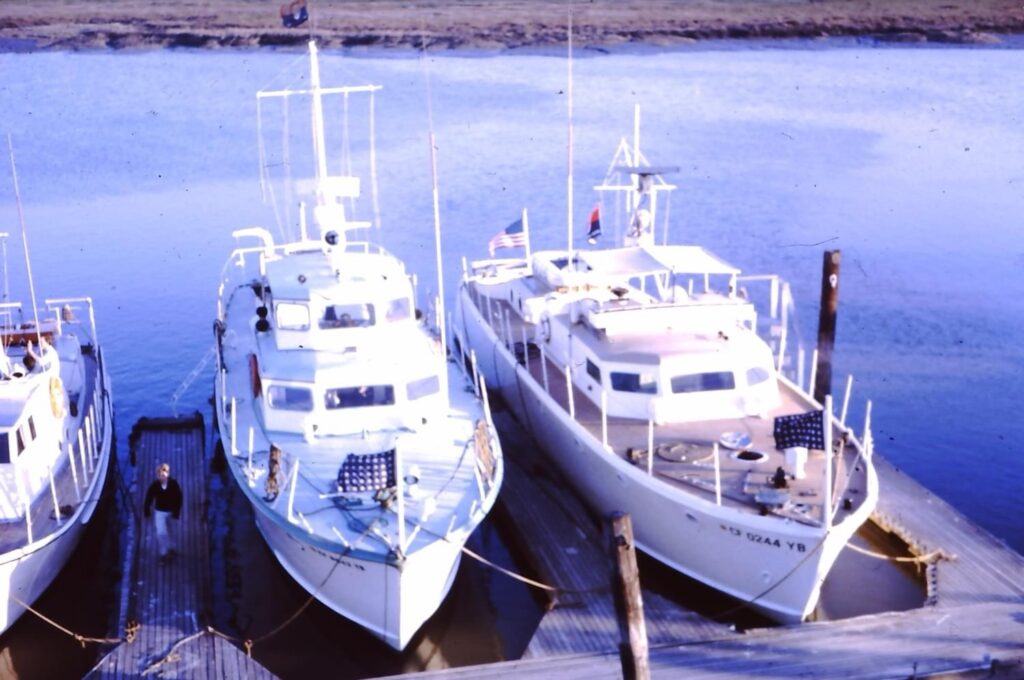
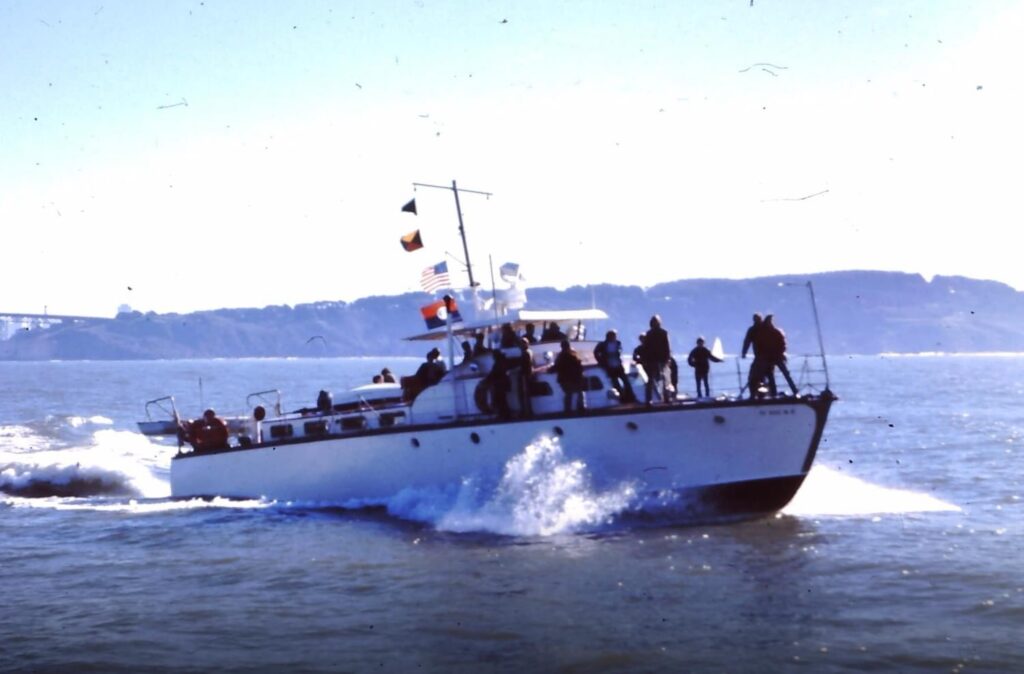
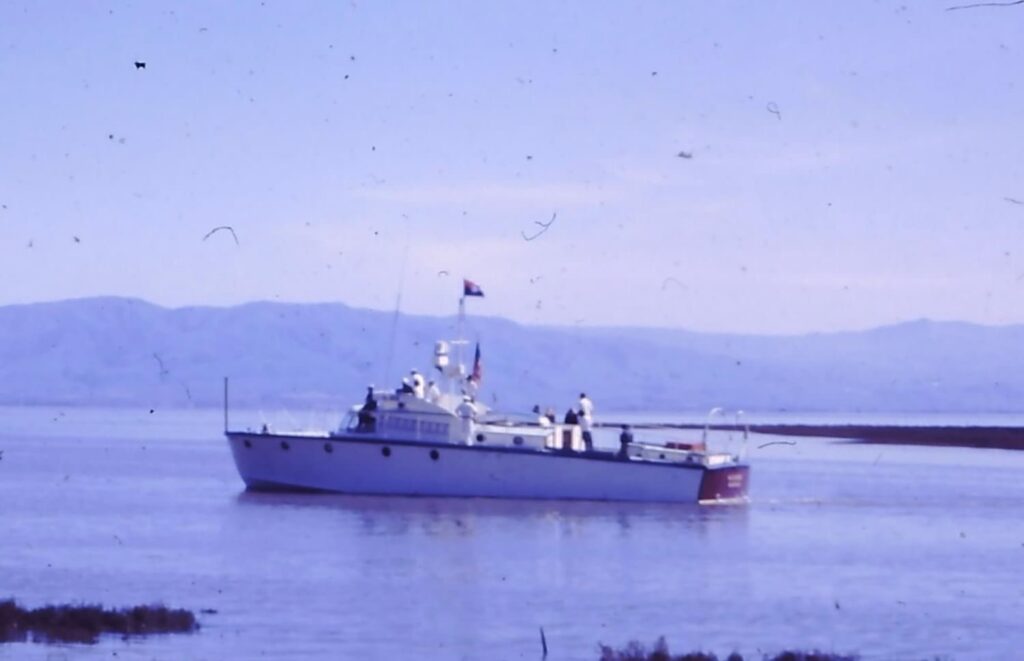
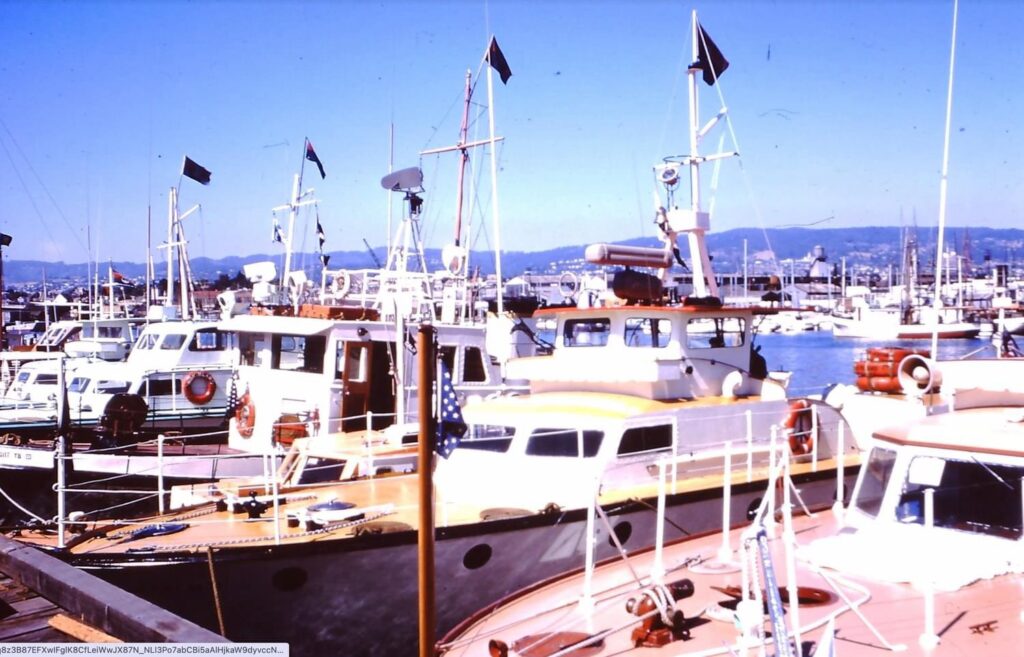
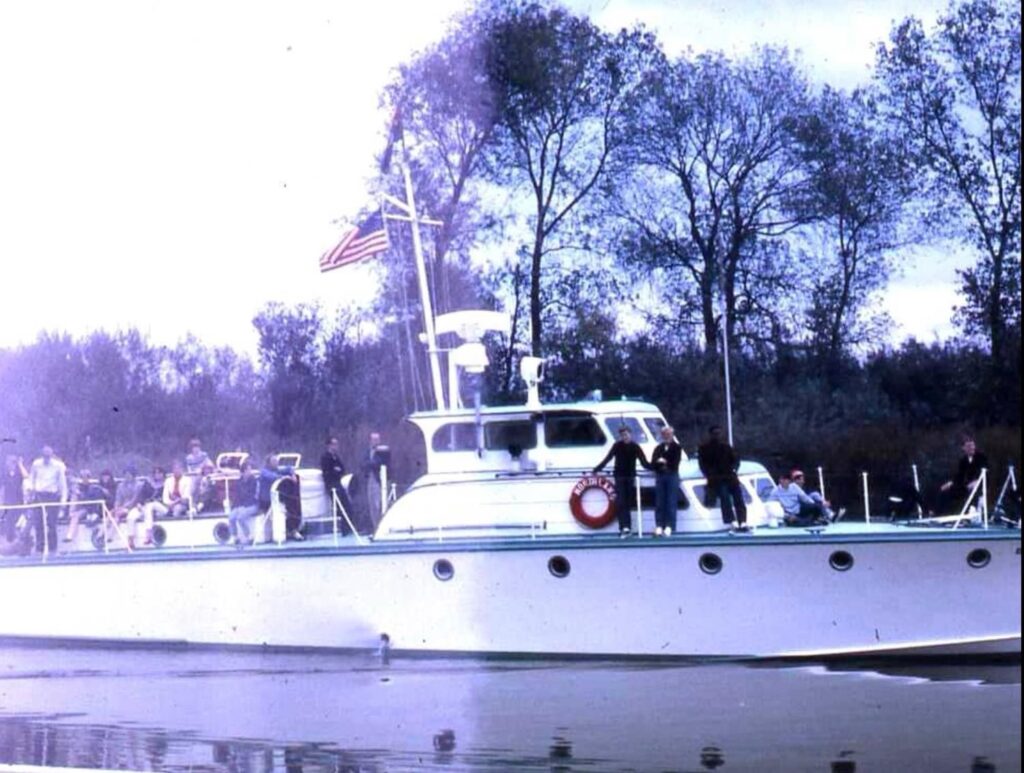
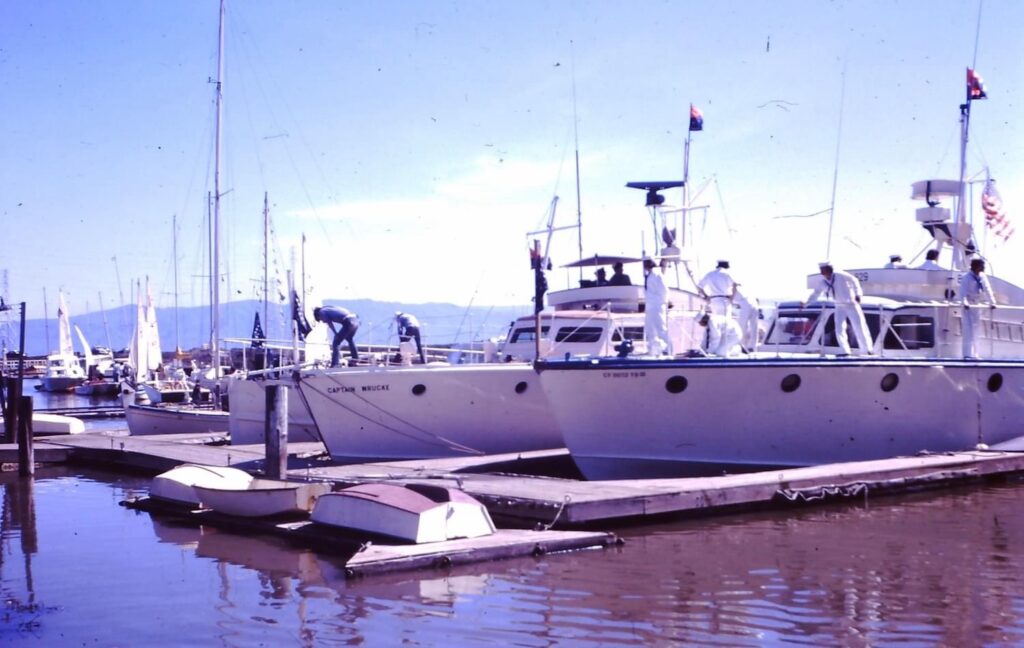
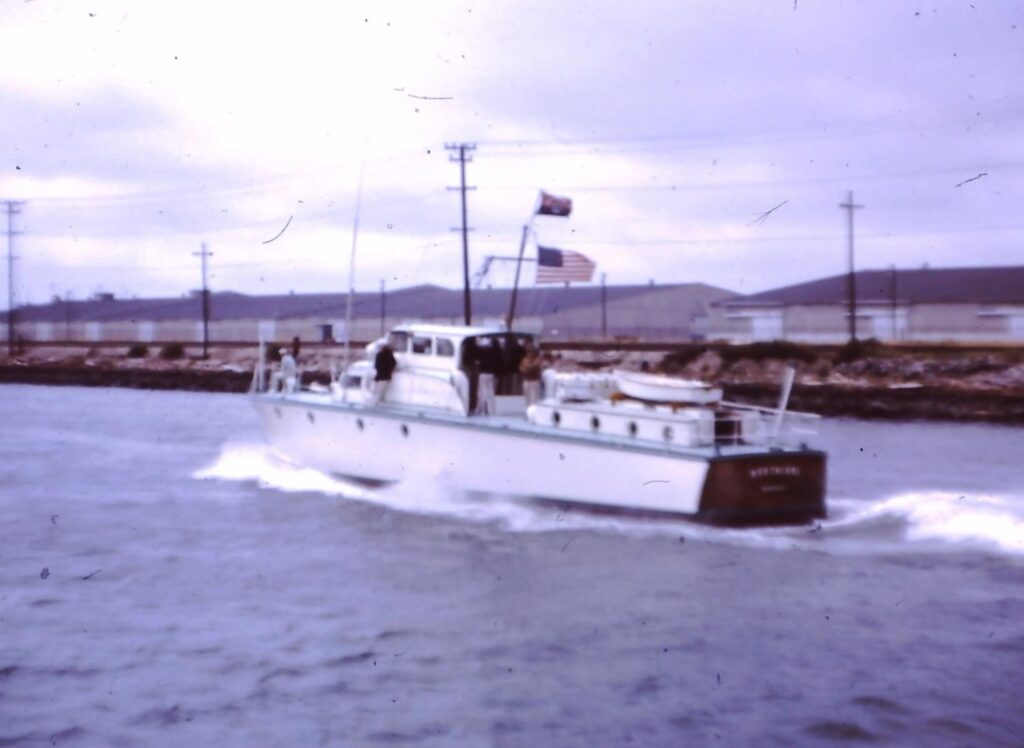
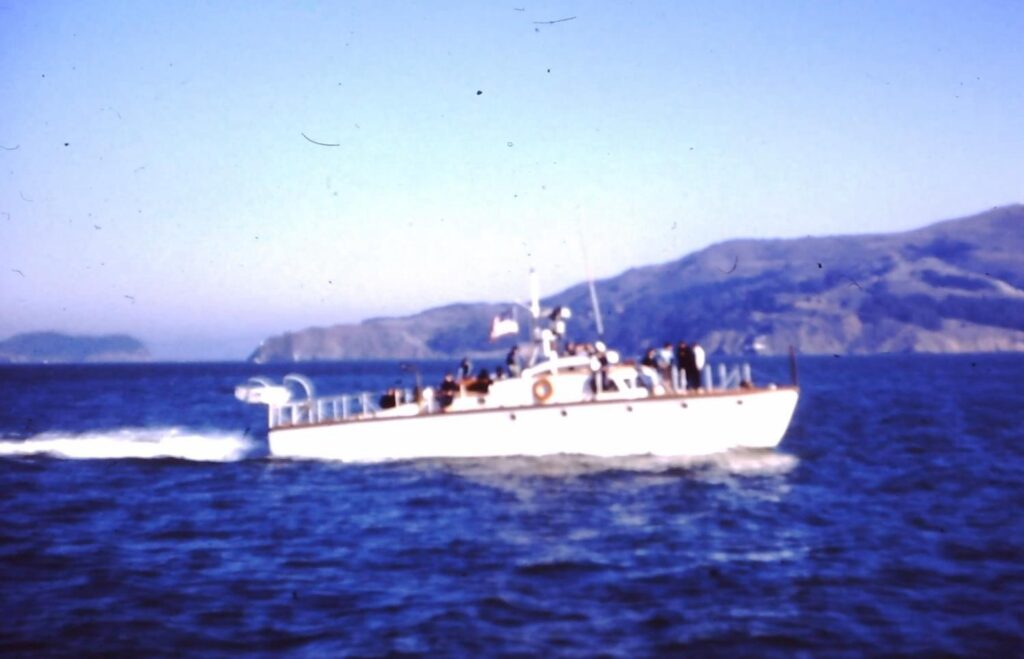
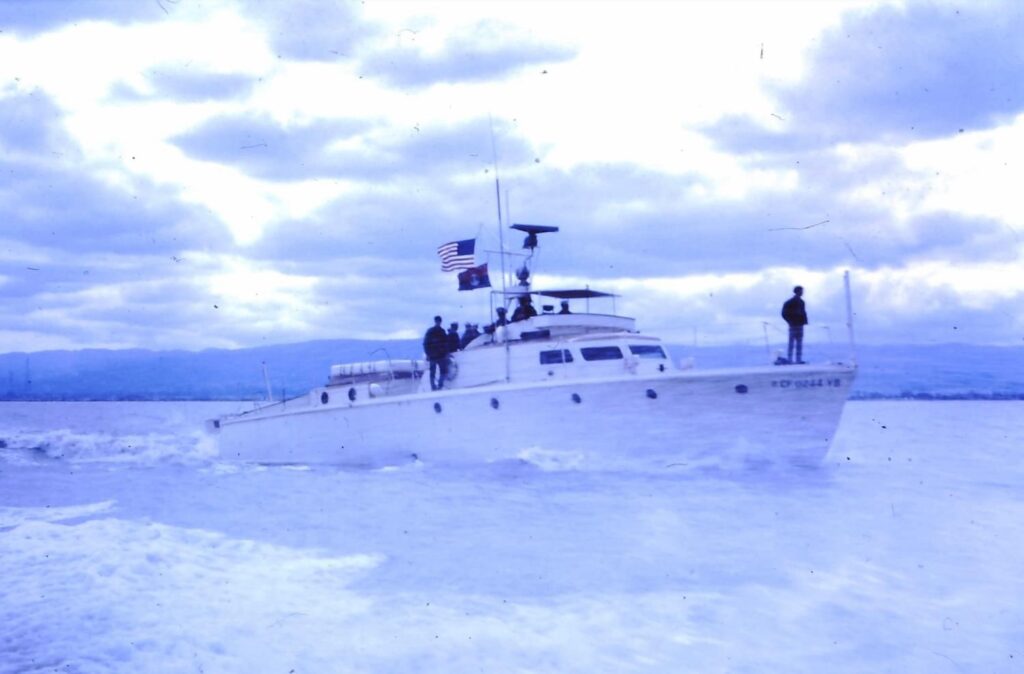
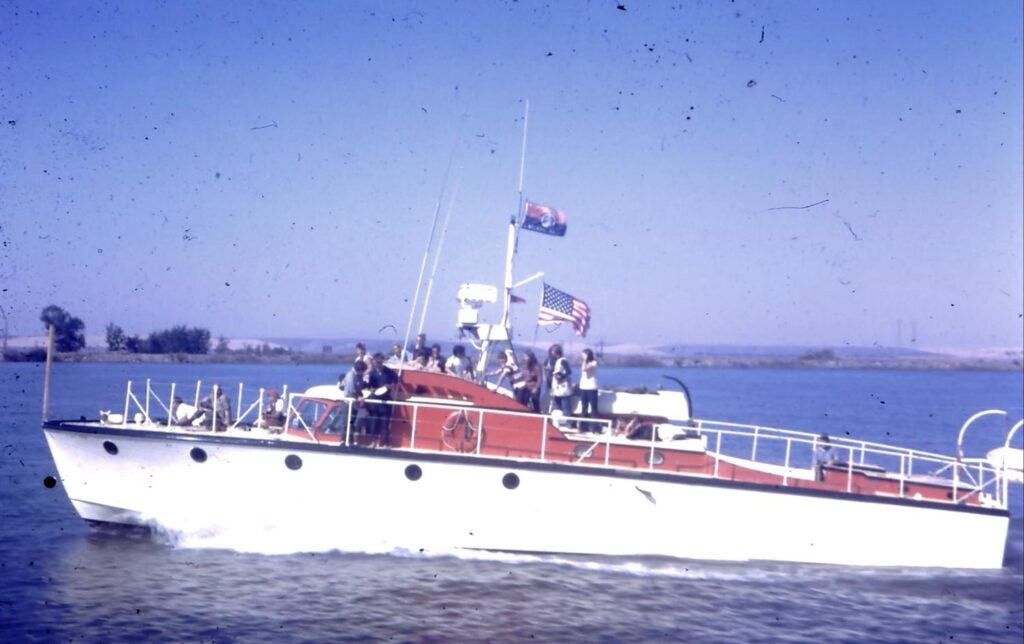
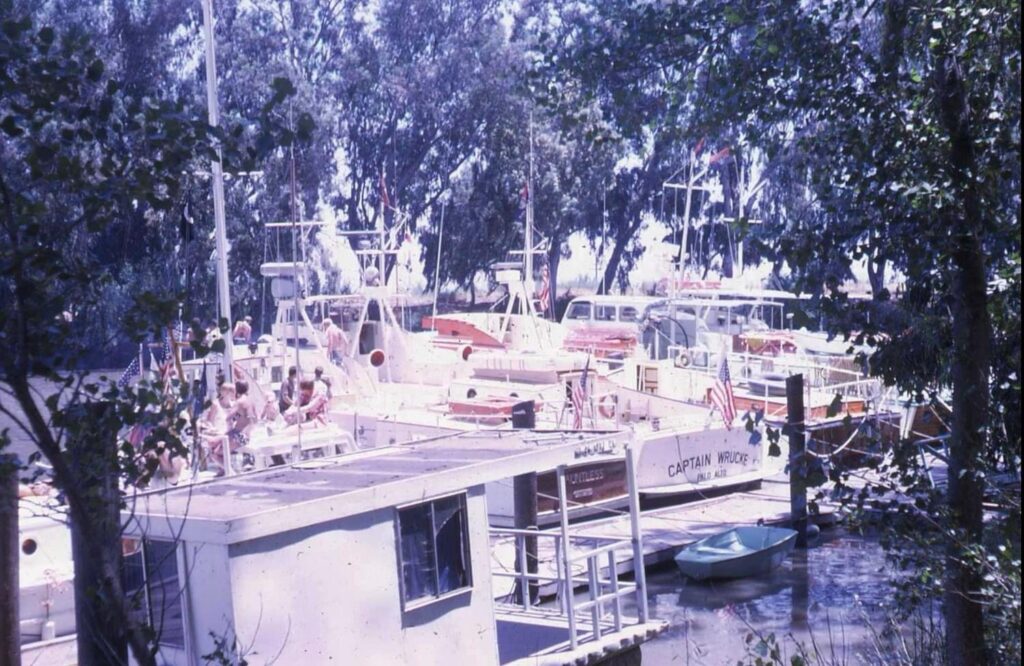
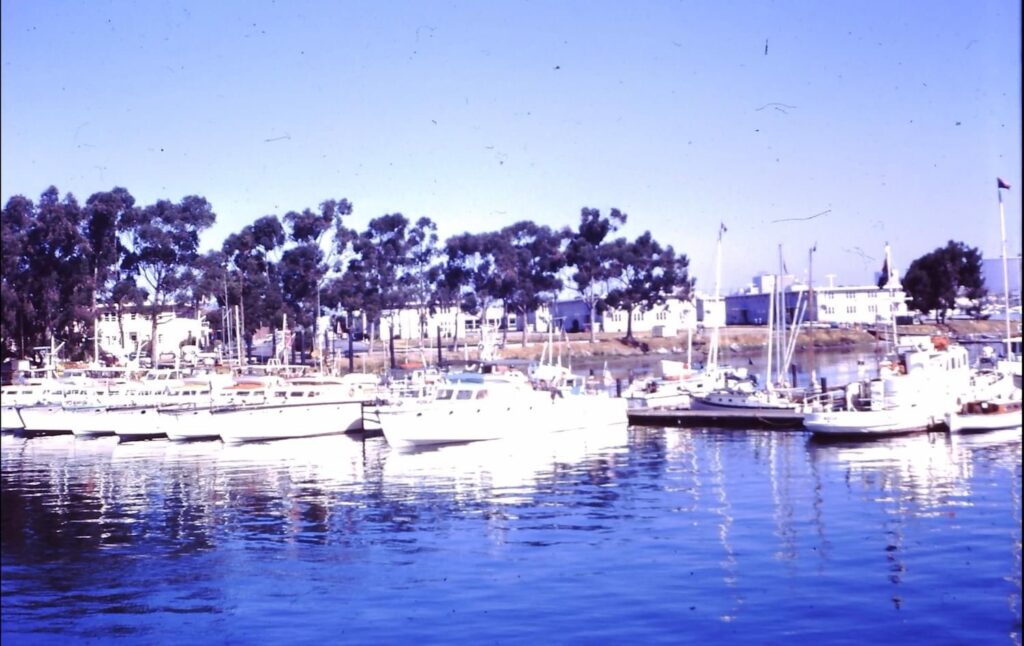
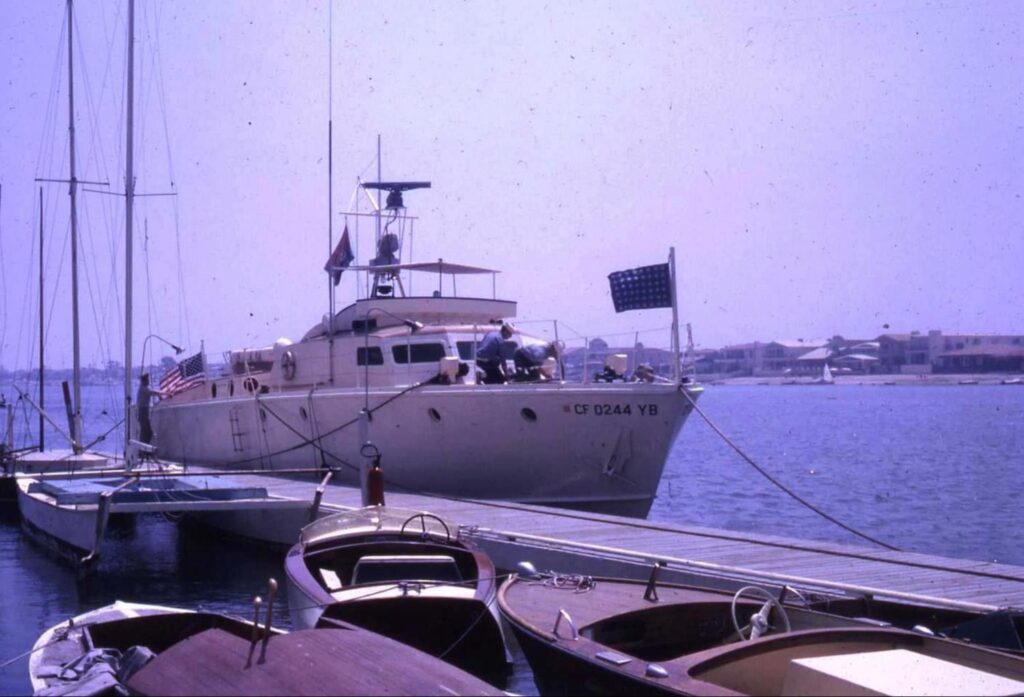
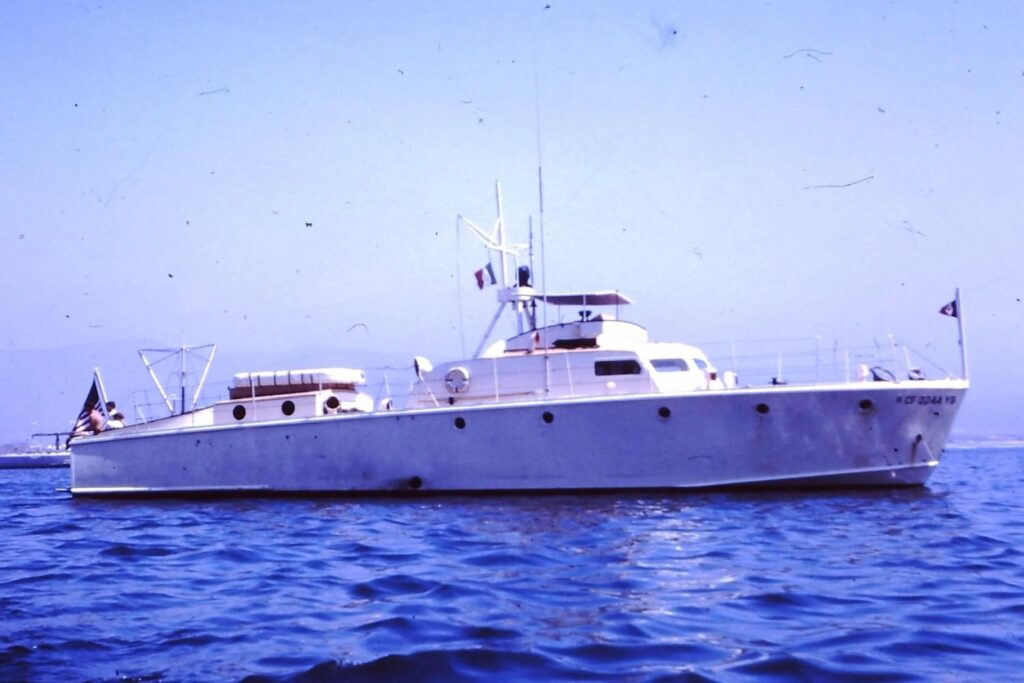
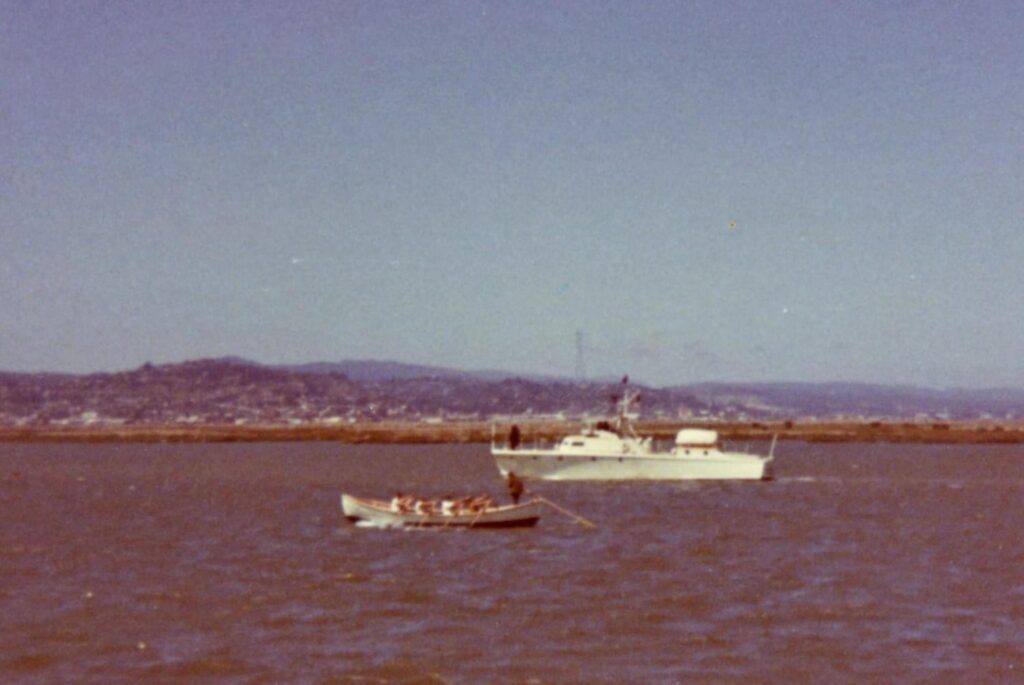
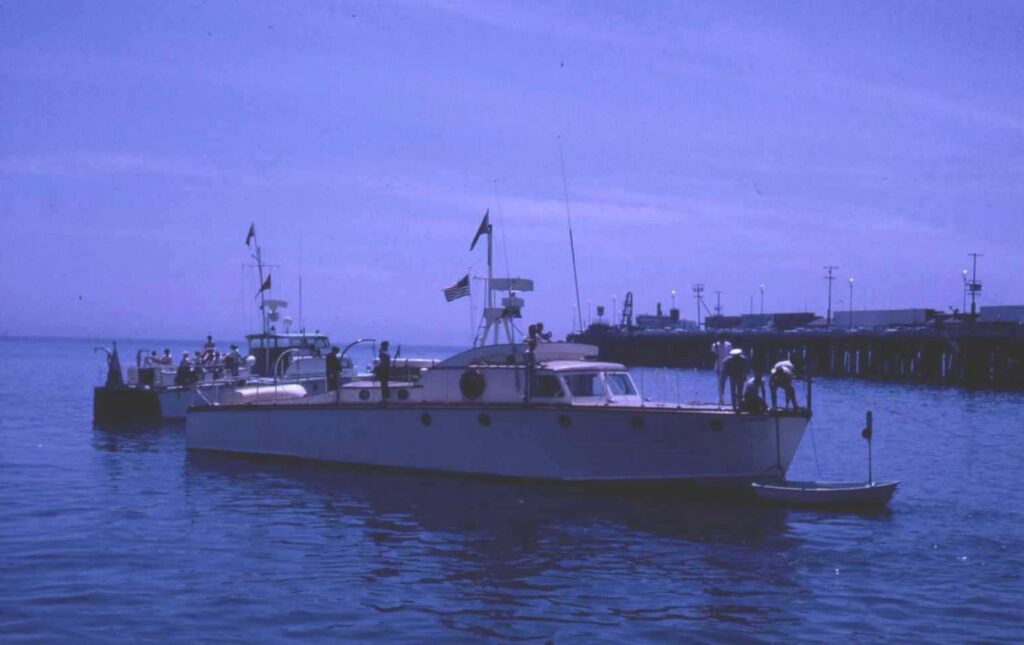
The AVRs were strategically positioned to cover areas where air operations were taking place, ensuring rapid response times for rescuing downed aircrews. Their deployment was global, covering both the Atlantic and Pacific theaters of war, as well as supporting training operations along the U.S. coasts.
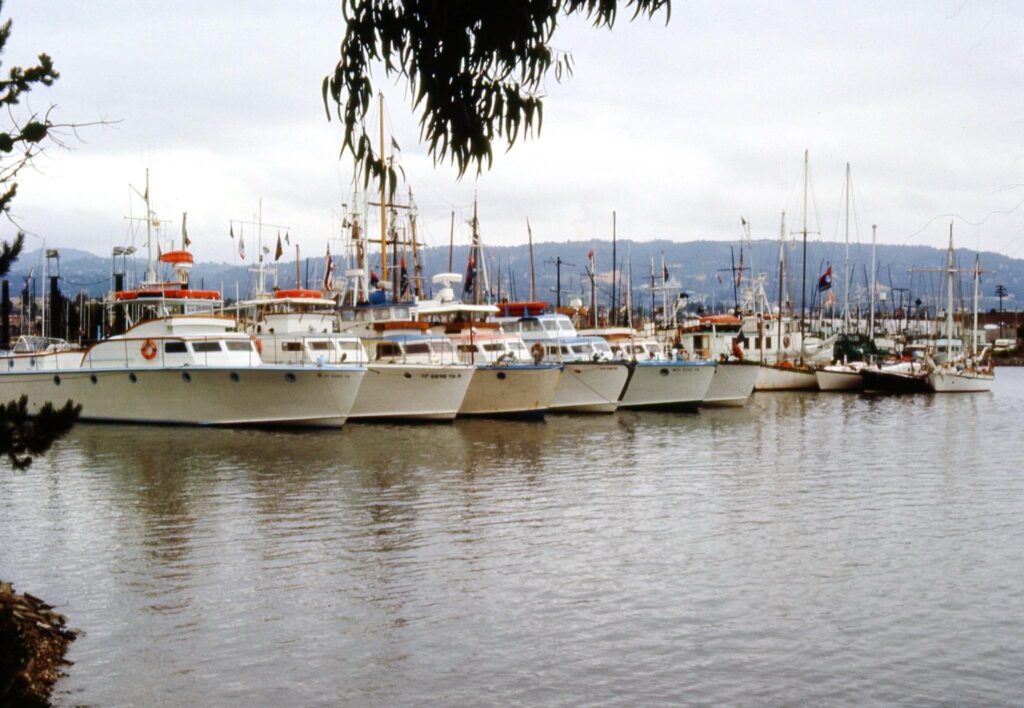
However, AVRs weren’t the only mechanism for saving pilots. Uffa Fox designed a boat that was dropped from aircraft.
During the Second World War, Uffa conceived the idea of the first parachuted Airborne Lifeboat. This vessel was carried beneath aeroplanes and dropped by parachute to survivors of ditched aircraft. The Airbornes had sails, engine, survival kit and instructions on how to sail them.
Many aircrews owed their lives to Uffa’s invention. For all his success in the field of yacht racing he maintained that this was his most fulfilling design.
Submarines were assigned lifeguard duties where they were forbidden to strike the enemy but instead waited to rescue flight crews and float planes were similarly assigned.
https://encyclopedia.pub/entry/36101
Naval Air Station North Island During WWII
Support for Pilot Training:
- Training Hub: NAS North Island was a major training base for Navy fighter and bomber pilots during World War II. It provided comprehensive training programs for pilots who would go on to serve in the Pacific Theater.
- Facilities: The base included various facilities for training, including runways, hangars, and maintenance facilities. It also hosted numerous aircraft carriers, which were integral to pilot training and operations.
- Aircraft: The station had a wide range of aircraft for training purposes, including fighters, bombers, and seaplanes.
Crash Boats and AVRs:
- Stationing of Crash Boats: While specific details about the stationing of 63-foot AVRs at NAS North Island are not provided in the search results, it is likely that various types of crash boats, including AVRs, were stationed there. These boats were essential for air-sea rescue operations, particularly given the base’s proximity to the Pacific Ocean.
- Role of Crash Boats: Crash boats were used to rescue downed pilots and aircrew from the water. They were equipped for quick response and could operate in coastal and intermediate offshore waters.
- 63-foot AVRs: The 63-foot AVRs were designed by Dair N. Long and were used extensively during WWII for air-sea rescue missions. They were lightly armed and relied on speed and maneuverability to perform their rescue operations.
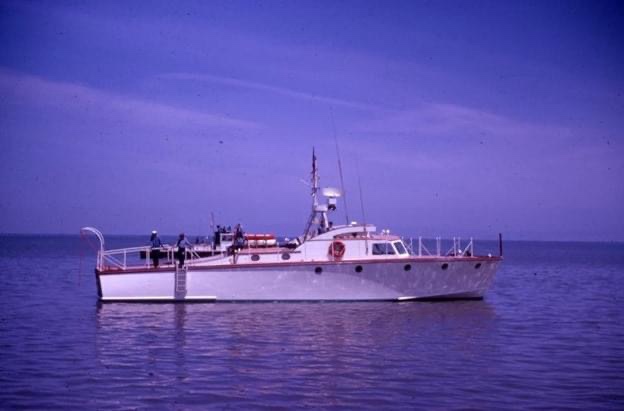
Construction and Deployment of AVRs
Construction:
- Design: The 63-foot AVRs were constructed using double diagonal planking, which provided hull strength and rigidity. This construction method involved laying two layers of planking at opposing 45-degree angles to the keel.
- Materials: Common woods used included mahogany, oak, and cedar, known for their strength and durability.
- Builders: Various shipyards, including Harbor Boat Building Company in Terminal Island, San Pedro, California, were involved in the construction of these boats.
Deployment:
- Operational Use: AVRs were deployed at strategic locations to provide rapid response for rescuing downed airmen. They were stationed near airbases and along coastal areas where air operations were frequent.
- Stationing at NAS North Island: Given NAS North Island’s role as a major training and operational base, it is plausible that AVRs were stationed there to support training missions and provide emergency rescue services.
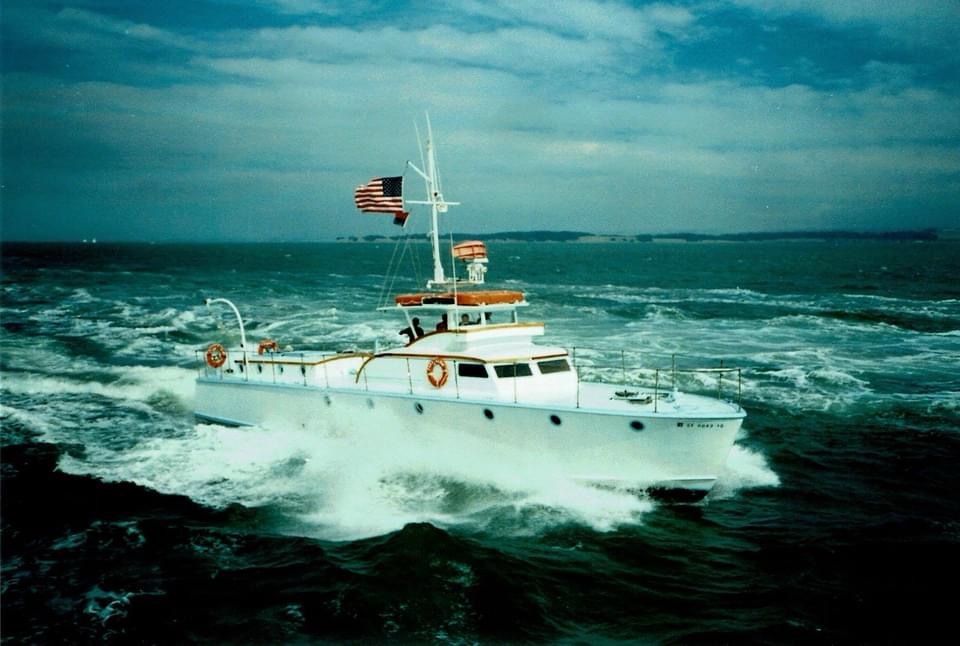
Conclusion
Naval Air Station North Island played a crucial role in training Navy pilots during World War II, supporting the Pacific Theater’s operational needs. While specific details about the stationing of 63-foot AVRs at NAS North Island are not provided in the search results, it is likely that various types of crash boats, including AVRs, were stationed there to support air-sea rescue operations. These boats were essential for ensuring the safety of pilots and aircrew during training and operational missions.
- Rescue of George H.W. Bush after his plane was shot down (September 1944) The future U.S. President was rescued by an AVR boat from the submarine USS Finback after being shot down during a bombing run over Chichi Jima.
- Mass Rescue after Battle of the Philippine Sea (June 1944) Multiple AVR boats from various ships participated in rescuing over 700 airmen and sailors from the water after this major carrier battle, which was one of the largest air-sea rescues of the war.
- Rescue of Aircrews from USS Franklin (March 1945) When the aircraft carrier USS Franklin was badly damaged by Japanese bombs, AVR boats played a crucial role pulling burned and wounded aircrews from the flaming wreckage and oil-covered waters around the ship.
- Rescue of Downed B-29 Crews over Japan The long-range AVR boats were sometimes the only rescue craft able to respond quickly enough to retrieve B-29 bomber crews that went down over or near the Japanese home islands.
- Rescue of Downed Pilots at Iwo Jima (February-March 1945) During the Battle of Iwo Jima, AVR boats stationed offshore conducted multiple rescues of pilots who were shot down or had to ditch their damaged planes in the waters around the island.
While the search results do not provide the specific names or hull numbers of the individual 63-foot AVR boats involved in these major rescues, they highlight how the speed, maneuverability and long range of these vessels made them indispensable for quickly retrieving downed aircrews from hostile waters during critical WWII battles and campaigns in the Pacific. Their role in saving hundreds of lives is well-documented.
AVR (Auxiliary Vessel, Rescue or Aircraft Vessel, Rescue) boats were used by several military organizations and built in various locations:
Military organizations that used AVRs:
- U.S. Navy
- U.S. Army Air Force (later U.S. Air Force)
- U.S. Coast Guard
- Allied navies, including Russian, British, Australian, Dutch, and South African armed forces.
Key points about AVR production and use:

- The boats ranged in size from 29′ to 94′, with the 63-foot and 85-foot models being the most common.
- A total of 740 63-foot Aircraft Rescue Boats were built, including variants.
- The 85 foot vessels were upscaled from the 63 footer. By definition these are ships. 63 footers by definition are boats.
- AVRs (both the 63 and 85 foot versions) were designed by Dair N. Long shortly before World War II.
- They were used primarily for rescuing pilots from downed planes in coastal and intermediate offshore waters.
- Some AVRs were assigned roles as sub chasers and patrol boats by the Navy.
- After World War II, many AVRs were sold to private parties or used for target practice, while some remained in service with the U.S. Air Force.

It’s worth noting that while Miami Shipbuilding Corporation was a major producer, the search results don’t provide a comprehensive list of all shipyards involved in AVR construction. The boats were likely built at multiple locations to meet the high demand during World War II.

Speed
Based on the search results, the 63-foot AVRs (Auxiliary Vessel, Rescue boats) had different speeds depending on the engine type:
Model 314 (standard design):
- Engines: Two 630-horsepower Hall-Scott Defender V12 petrol engines
- Top speed: 31.5 knots (58.3 km/h; 36.2 mph)[3]
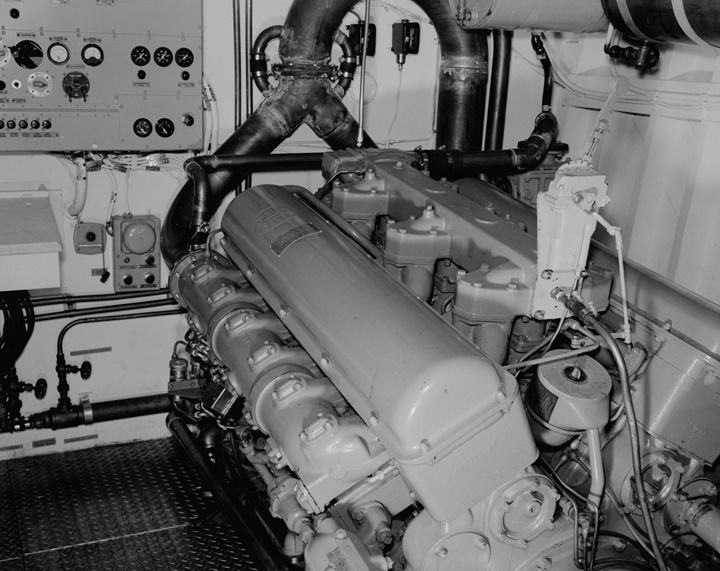
Model 168 (US Navy version):
- Engines: Two 1250-hp Packard 4M-2500 marine engines
- Top speed: 48 knots (approximately 55 mph)[2][3]
British version (Model 152):
- Engines: Twin V12 Hall-Scott “Defender” engines (1260hp total) using V-drives
- Top speed: 36 knots (42 mph)
Regarding fuel:
- The Packard V12 4M-2500 engines used in the 85-foot crash boats (and in the 63-foot Model 168) used 91 to 100 octane gasoline.
- The search results don’t specifically mention the fuel type for the Hall-Scott Defender engines, but they are described as “petrol engines,” indicating they also used gasoline.
It’s worth noting that fuel capacity varied between models:
- Model 314 had two rigid 795-US-gallon (3,010 L; 662 imp gal) United States Rubber Company bullet sealing fuel tanks.
- Model 168 had three fuel tanks, though the capacity isn’t specified[3].

The different engine configurations and fuel capacities allowed for various performance characteristics, with the Packard-powered Model 168 achieving the highest top speed among the 63-foot AVRs.
U.S. Coast Guard’s use of AVRs
The Coast Guard received 29 of the Model 314 63-foot rescue boats. These became the standard 63-foot rescue boat for the Coast Guard during World War II and into the 1950s.
In August 1944, the Navy delegated primary responsibility for Search and Rescue (SAR) to the Coast Guard. This led to the establishment of Air-Sea Rescue Task Units at Coast Guard Air Stations.
On December 1, 1944, the Commandant of the Coast Guard established the Coast Guard Office of Air-Sea Rescue to deal with aspects of air-sea rescue operations involving Coast Guard vessels, aircraft, and shore stations.
The Coast Guard integrated these rescue boats into their broader air-sea rescue operations, which included aircraft, 65-foot and 104-foot rescue boats, subchasers, Coast Guard Cutters, and lifeboat stations.
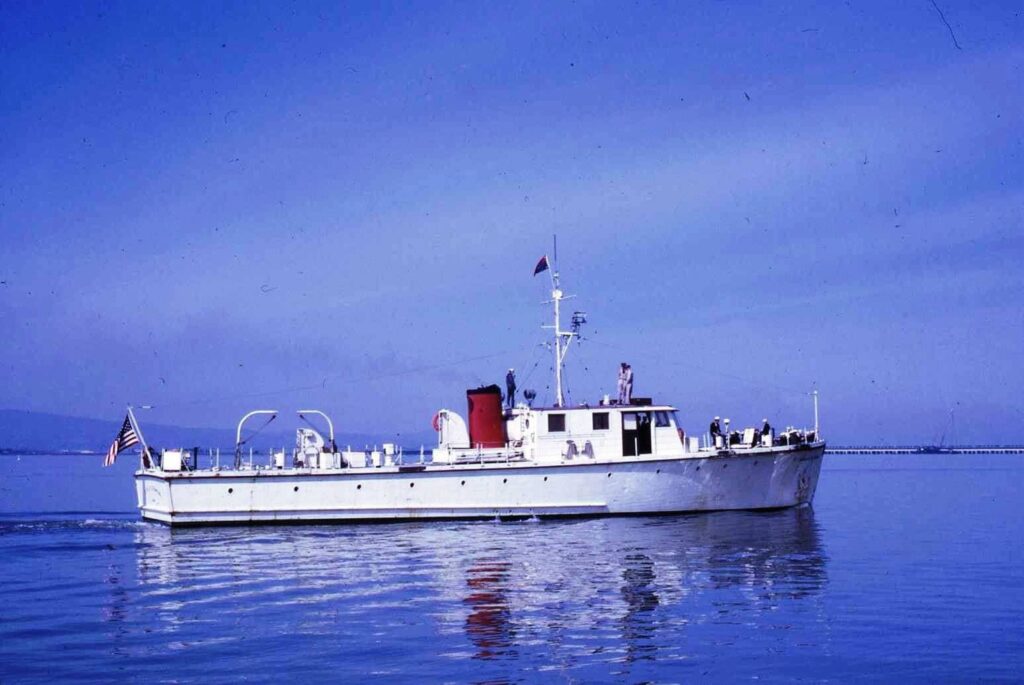
The Sea Scout group that operated the Barclay Stevens was known as the S.S.S. (Sea Scout Ship) Barclay Stephens, designated T-450. (Tug 450). She was an old 104-foot Boat from the Korean war, built for the invasion of Inchon but never used. She served as an Army Tug boat before being donated to the Alameda California Sea Scout crew. Active at least during the late 1980s, the Barclay Stevens was involved in organizing the Ancient Mariner Regatta from the early 1950s, indicating the ship’s involvement in Sea Scouting activities in Northern California during that era as well.
Assignment to a 63ft crash boat was considered “preferred duty” and only given to experienced seamen, generally those who had completed a tour of duty outside of U.S. waters. Typically they were skippered by an ensign plus four seamen, three engineers, a radio operator and a pharmacist. Coast Guard 63s generally had some unique equipment not found on the Army and Navy crash boats. They were often equipped with wet suits, asbestos firefighting suits, blood plasma, very basic diving gear, and oxygen tanks.
The 63 ft and 85 ft. rescue boats did not remain in Coast Guard service very long. Most were retired by the end of 1947 as the Hall-Scott engines were considered “gas hogs” after the war. Due to the much smaller Coast Guard budgets, many of the boats were given to the Sea Scouts.
It’s worth noting that while AVRs played a significant role in World War II rescue operations, their use began to decline after the war. By the Korean War, helicopters had largely taken over the role of rescuing pilots and aircrews. However, the Coast Guard continued to use these boats into the 1950s as part of their rescue fleet.
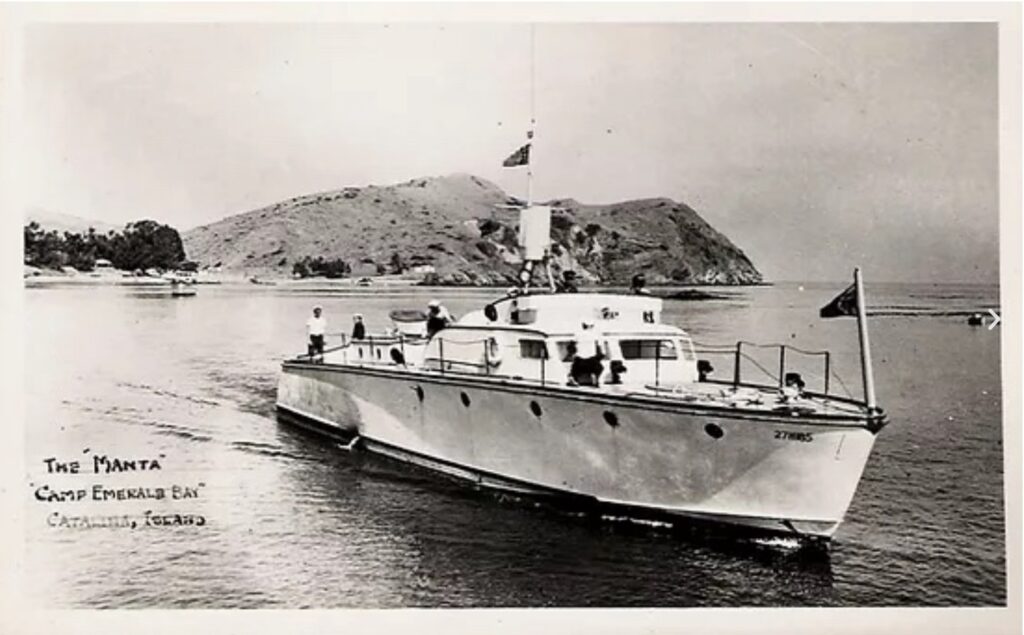
AVR boats were acquired by Sea Scouts after World War II, typically for the price of $1.
- Sea Scout Ship 16, one of the oldest continuously registered Sea Scout ships in the United States, acquired a 63-foot AVR boat in 1946.
- The boat was obtained from the Navy after the war and assigned to Ship 16 by the Crescent Bay Council of the Boy Scouts of America.
- This particular AVR was built by Fellows and Stewart in San Pedro, California.
- The original Hall-Scott V-12 gasoline engines were removed and replaced with two 671 Grey Marine diesels.
- The boat was named “Manta” and began operating in 1946, transporting scouts, supplies, and staff to Camp Emerald Bay.
It’s worth noting that many military vessels, including AVRs, were sold or transferred to civilian organizations after World War II. The acquisition of the Manta by Sea Scout Ship 16 in 1946 aligns with this post-war period when surplus military equipment was being repurposed.
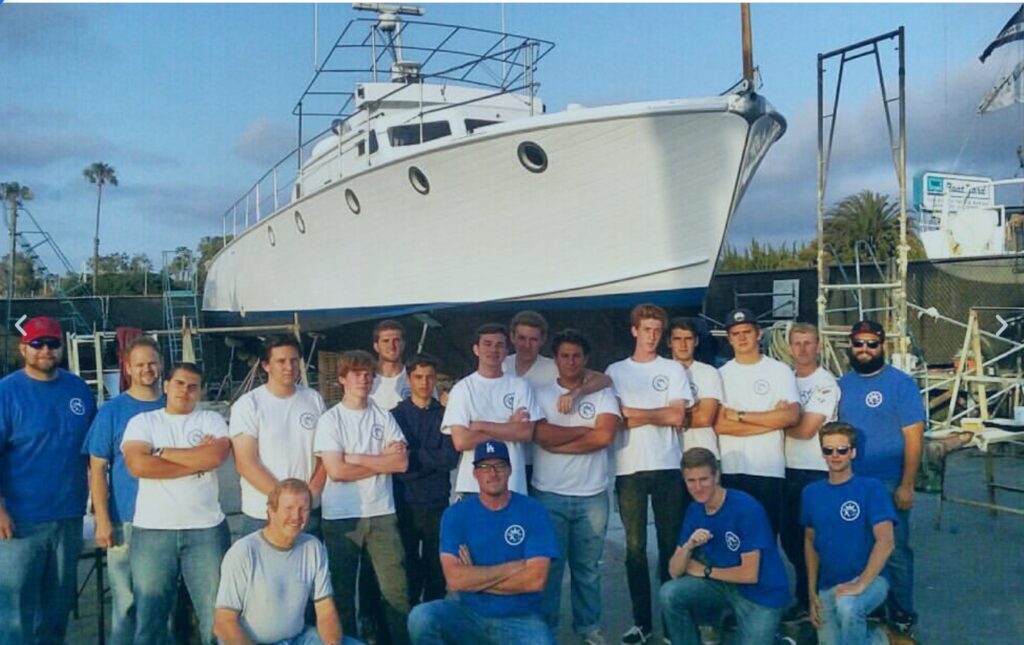
63 foot AVR boats were sold to Sea Scouts for one dollar. The Northland (Ship 52) is known to have been purchased for $1.
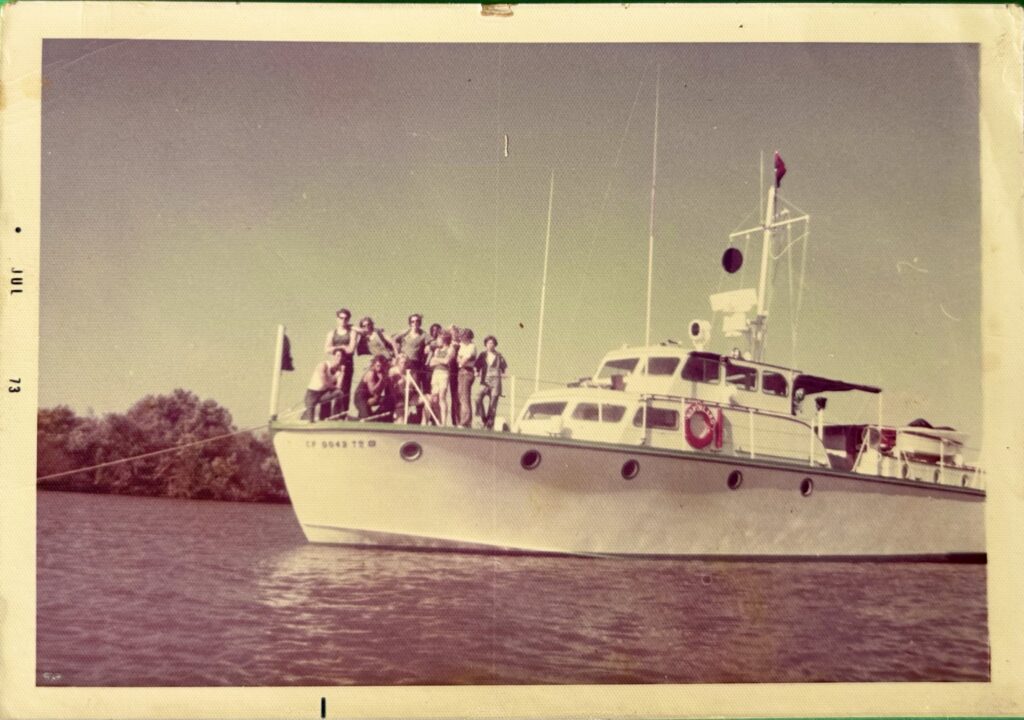
Based on the provided search results, here are some key details on how the Ancient Mariner Regatta has evolved over the years:
Origins and Early Years:
- The Ancient Mariner Regatta (AMR) began in 1952 and was originally hosted at Coast Guard Island in Alameda, California.
- In its early years, the regatta was closely tied to the U.S. Coast Guard base on Coast Guard Island. Sea Scouts were only a few years younger than those recruited and being trained on the island and wore identical daily uniforms (chambray shirts and bell bottom pants).
- Many sea scouts held draft cards designed 1H (the H stood for “holding”) which when modified slightly (the H changed to an A) would give access to areas of the island not otherwise accessible (like the Blue Dolphin bar).
- The drinking age on the island was 19 (the Federal standard) where the drinking age in California was and currently is 21.
Venue Changes After 9/11:
- After the 9/11 attacks in 2001, heightened security measures at the Coast Guard base made it difficult to continue hosting the regatta there.
- As a result, the regatta temporarily relocated to the Sea Scout Base in Stockton for some years.
- It then found a home aboard the USS Hornet aircraft carrier museum in the San Francisco Bay for several years.
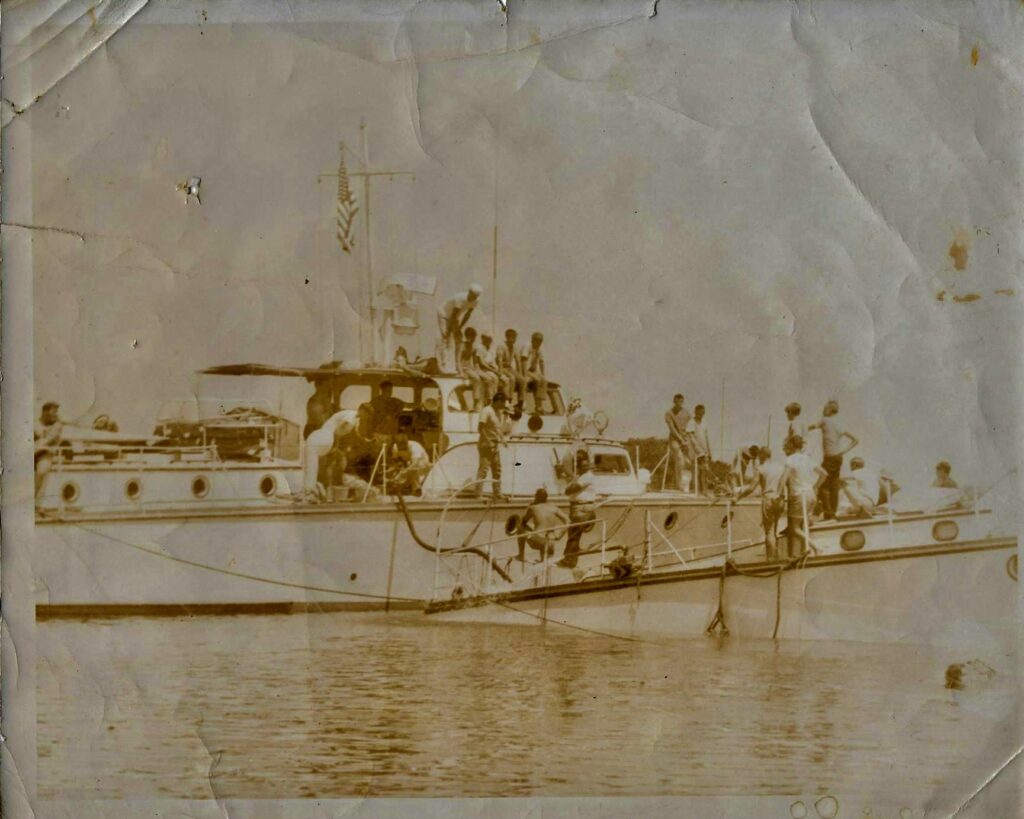
Move to California Maritime Academy:
- The regatta eventually moved to the California Maritime Academy (CMA) in Vallejo, where it has been held in recent years.
- This allowed the regatta to have a home that maintained its connection to the maritime environment.
- CMA attracts sea scouts into its four year college where top graduates are offered officer commissions into the US Navy.
Participation and Events:
- The regatta continues to attract Sea Scout Ships, Mariner Scouts, and Venture Crews from across California to compete in various events.
- Traditional events like sailing, swimming, knot tying, and pulling boat races have remained core components of the regatta over the decades.
- Some new events may have been added or modified over time, but the overall structure has largely remained intact.
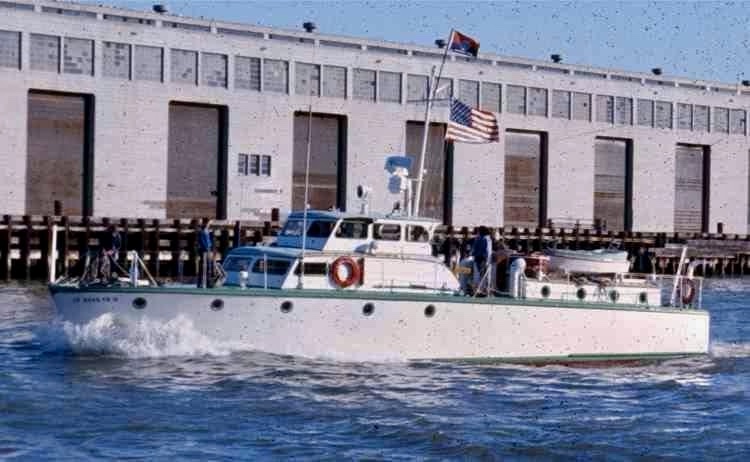
Fee Increases:
- In 2022, the regatta committee announced a fee increase to $175 per person, citing the need to cover the rising costs of operating the event at CMA.
- This highlights the financial challenges of sustaining such a large-scale regatta over many years.
- Sea Scouts over the age of 13 are offered membership in the Coast Guard Auxiliary which may cover some or all regatta fees. This is a new program implemented after the pandemic. The Coast Guard Auxiliary is under direction of the U.S. Coast Guard Commandant. This is a big deal for both Sea Scouts and the US military.
COVID-19 Impact:
- The regatta was forced to cancel its 2020 and 2021 editions due to the COVID-19 pandemic.
- It successfully returned in 2022 after a two-year hiatus, marking a significant milestone in its continued evolution and resilience.
So in summary, while maintaining its core maritime traditions, the Ancient Mariner Regatta has adapted over the decades by changing venues multiple times, adjusting to security concerns, and addressing financial challenges through fee increases. Despite disruptions like the COVID-19 pandemic, the regatta has shown its ability to evolve and persevere as a cherished event for Sea Scouts in California.
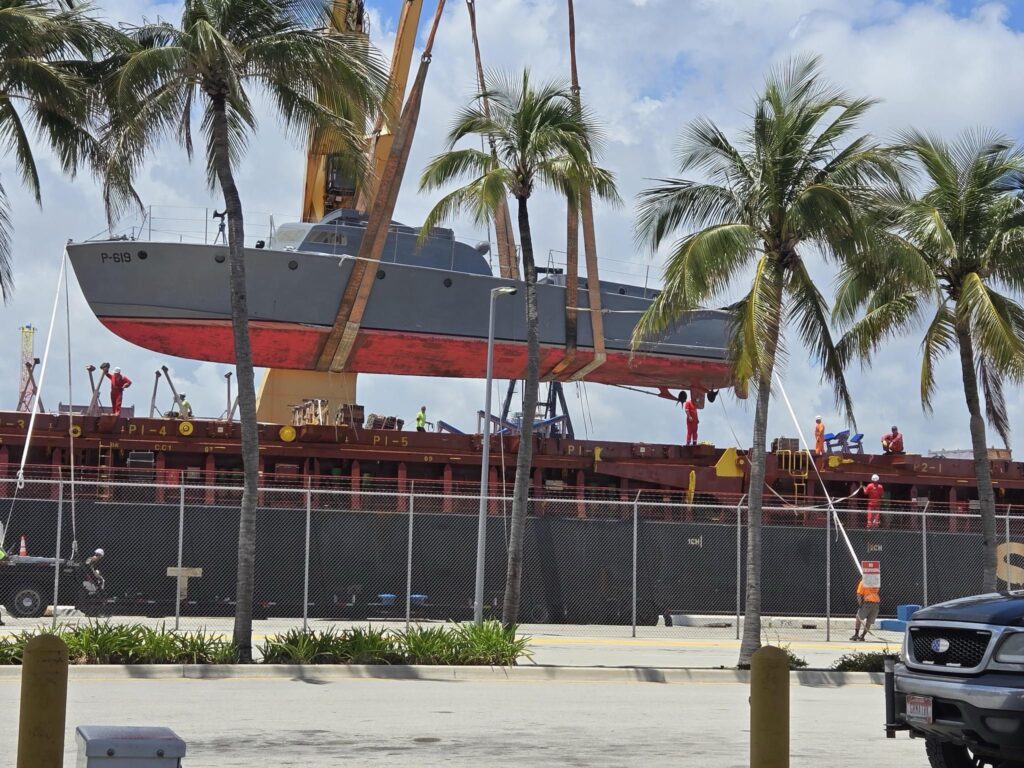
The search results indicate that:
- The Old Salts’ Regatta, another major Sea Scout event in the San Francisco Bay Area, has been hosted at Coast Guard Base Alameda, including the upcoming 2024 regatta .
- The Ancient Mariner Regatta has traditionally been held at the California Maritime Academy in Vallejo.
- The Sea Scout Ship Viking (Ship 100) based in San Francisco is highly active and has participated in major regattas like the Ancient Mariner Regatta over the years.
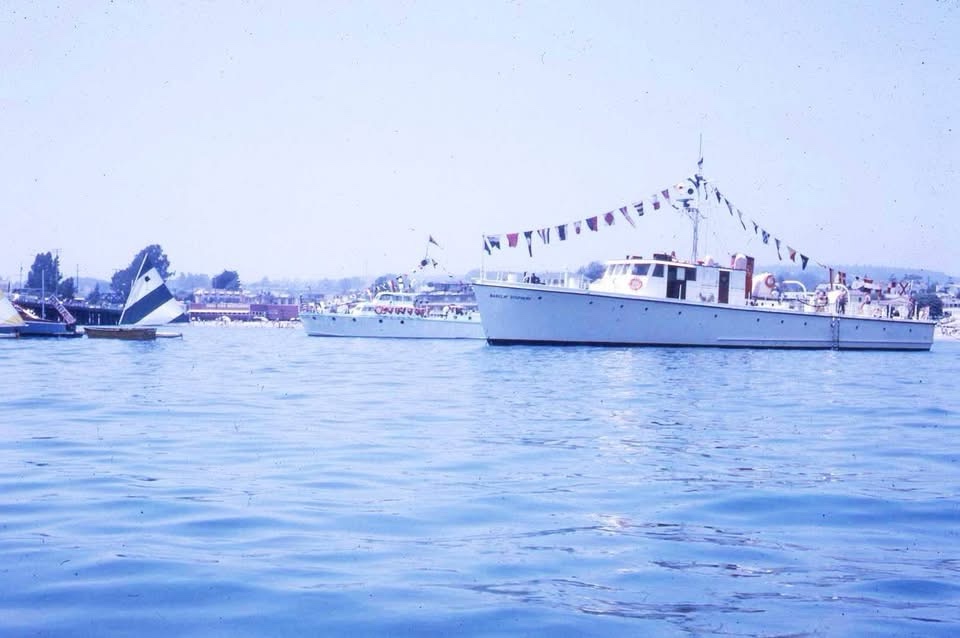
As for the future, while the search results do not explicitly state plans, there are a couple of relevant points:
- The Old Salts’ Regatta is confirmed to be taking place at Coast Guard Base Alameda in 2024 , continuing the tradition of the Coast Guard hosting this event.
- For the Ancient Mariner Regatta, the 2023 update does not mention a venue, but states they are working on details for the upcoming regatta season.
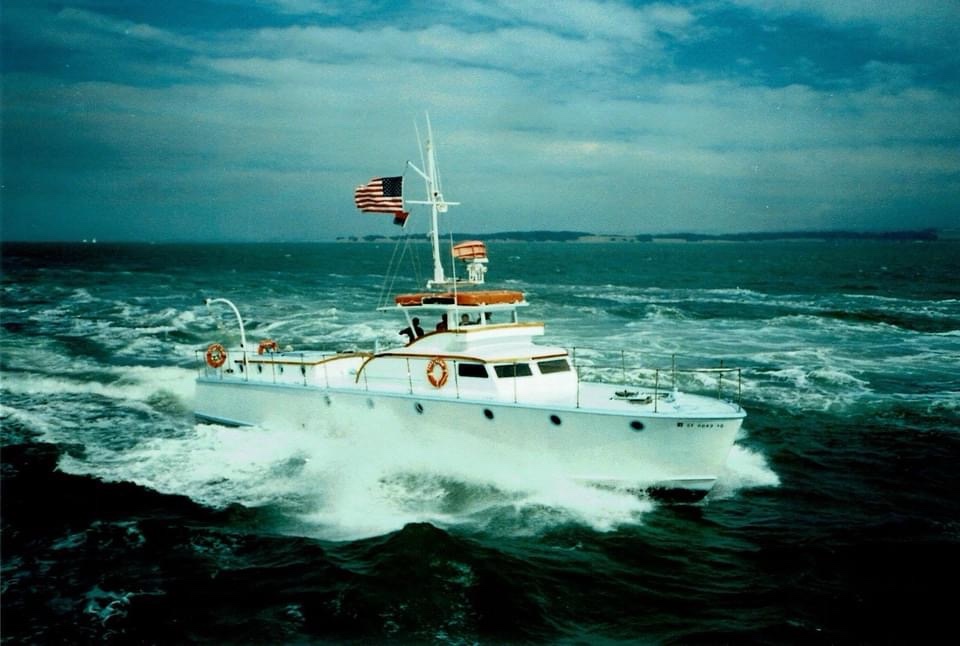
The Coast Guard has hosted major Sea Scout events like the Old Salts’ Regatta at Coast Guard Base Alameda in the past in and will do so in the future, given the Coast Guard’s support for Sea Scout as Coast Guard Auxiliary. The California Maritime Academy appears to have been the traditional venue for this specific regatta based on the search results.
The key relevant points from the search results are:
- The Coast Guard established Base Alameda in 2012 to provide support services for Coast Guard activities along the West Coast .
- There are details on Base Alameda’s access procedures, parking, and the various tenant commands located there , for references to Sea Scout units.
- The search results confirm the partnership between the U.S. Coast Guard Auxiliary and the Sea Scouts program starting in 2018 . This allows Sea Scouts to benefit from Coast Guard training and seamanship education.
- One result mentions a new Sea Scout Ship (unit) called Ship 317 Delta Mariner being established in Suisun City in 2023, sponsored by a local Coast Guard Auxiliary flotilla.
- There is a listing for a “SEAL 2019 – Alameda, CA” event on the Sea Scouts website , but no additional context is provided about this event or if it involved Base Alameda.
So in summary, while the search results highlight the overall Coast Guard Auxiliary partnership with Sea Scouts and mention some Sea Scout units in the broader Bay Area, the first use of the Coast Guard’s Base Alameda installation in many years will be in 2024.
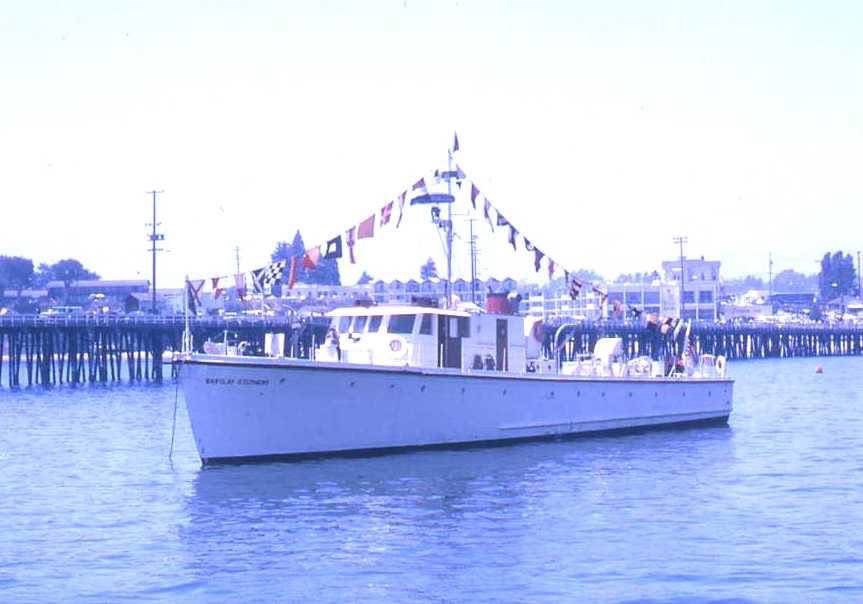
Battle of Britain
The Battle of Britain was a major air campaign fought in the skies over the United Kingdom in 1940 between the Royal Air Force (RAF) and the German Luftwaffe. Some key points about AVR boats and their relation to this period:
- AVR boats were primarily used for air-sea rescue operations, not downing planes.
- While AVR boats weren’t involved in the aerial combat of the Battle of Britain, they played a role in rescuing downed pilots from the English Channel and North Sea during and after the battle.
- The British Power Boat Company built their own version called the Type Two 63 ft HSL (High Speed Launch) crash boat for the UK from 1937.
- The 63-foot AVR boats were designed shortly before World War II by Dair N. Long.
- Some USA built AVR boats were sent to Great Britain under Lend-Lease agreements:
- The British version (Model 152) had twin V12 Hall-Scott “Defender” engines with 1260hp total and a top speed of 36 knots.
- Model 152 AVR boats were sent to Great Britain. These had Watson-Flagg VeeDrive Gearboxes added to them.

Some general information about V-drives and their advantages is provided below.
- Engine placement: V-drives allow the engine to be placed further aft in the boat, which can improve weight distribution and free up space amidships for other uses.
- Efficiency: V-drives are generally more efficient in delivering horsepower to the prop, losing only about 8% compared to 13% for sterndrives.
- Propeller options: V-drives allow for larger diameter propellers, which can improve low-speed handling and provide more options for propeller selection.
- Wake characteristics: V-drives produce a cleaner, flatter wake behind the boat.
- Simplicity: Compared to sterndrives, V-drives have fewer components, potentially reducing maintenance needs and corrosion concerns.

It’s important to note that while V-drives offer the above advantages, sterndrives generally provide better overall performance in terms of speed and fuel efficiency.
Again while AVR boats were valuable for rescue operations, they were not combat vessels and did not participate directly in battles. Torpedoes and Aircraft Artillery are heavy and, for each 100 pounds added to the total weight of a speedboat, 1 MPH less top end performance can be expected. The AVRs role was supportive, focusing on the rescue and recovery of aircrews who had been shot down or crashed into the sea. Speed, not fire power or fuel capacity, was emphasized in their builds and operation.
submarine USS Finback
USS Finback (SS-230)
The USS Finback (SS-230) was a Gato-class submarine of the United States Navy, commissioned on January 31, 1942. It was involved in numerous successful patrols during World War II, earning 13 battle stars and sinking nearly 70,000 tons of enemy shipping. The submarine was decommissioned on April 21, 1950, and eventually sold for scrap in 1959.
George H.W. Bush’s Rescue
On September 2, 1944, Lieutenant (j.g.) George H.W. Bush, a pilot in the U.S. Navy, was flying a Grumman TBF Avenger during a bombing mission over Chichijima in the Bonin Islands. His plane was hit by anti-aircraft fire, forcing him to bail out over the ocean. Bush managed to parachute into the water, but unfortunately, his two crew members did not survive.
Duration in Water and Rescue
Bush was in the water for approximately four hours before being rescued. During this time, he was in a life raft, facing the imminent threat of Japanese forces. American fighters provided cover, preventing Japanese boats from capturing him.
Role of the USS Finback and AVR Boats
The USS Finback was on lifeguard duty in the Bonin Islands area when it rescued Bush. The submarine’s crew spotted and rescued Bush and used a 63-foot AVR (Aircraft Vessel, Rescue) boat to transfer him from the submarine. The AVR boats were designed for high-speed rescue operations and were equipped to handle such missions effectively.
Other Rescues by USS Finback
During its tenth war patrol, the USS Finback rescued a total of five downed pilots, including Bush. The submarine was frequently assigned to lifeguard duty, providing crucial support during aircraft strikes and rescuing aviators who had been shot down.
Summary
- Submarine: USS Finback (SS-230), a Gato-class submarine.
- Pilot: George H.W. Bush, flying a Grumman TBF Avenger.
- Incident: Bush’s plane was hit during a bombing mission over Chichijima, forcing him to bail out.
- Time in Water: Approximately four hours.
- Rescue: Conducted by the USS Finback using a 63-foot AVR boat.
- Other Rescues: The USS Finback rescued a total of five downed pilots during its tenth war patrol.
The rescue of George H.W. Bush by the USS Finback is a notable event in both naval and presidential history, illustrating the critical role of submarines and rescue boats in wartime operations.
Battle of the Philippine Sea
The Battle of the Philippine Sea was a major naval engagement during World War II, taking place on June 19-20, 1944. It was part of the larger Mariana and Palau Islands campaign and resulted in a decisive victory for the United States Navy over the Imperial Japanese Navy.
Key points about the battle:
- It was the largest carrier-to-carrier battle in history, involving 24 aircraft carriers and roughly 1,350 carrier-based aircraft.
- The battle earned the nickname “The Great Marianas Turkey Shoot” due to the disproportionate losses suffered by Japanese aircraft.
- U.S. forces were led by Admiral Raymond Spruance, commanding the Fifth Fleet, with Vice Admiral Marc Mitscher in charge of Task Force 58 (the Fast Carrier Task Force).
- Major U.S. carriers involved included USS Essex, USS Lexington, USS Bunker Hill, USS Cowpens, USS Princeton, and USS Belleau Wood.
- Japanese carriers included Taihō, Shōkaku, Zuikaku, Junyō, Hiyō, and several light carriers.
Regarding the role of 63-foot and 85-foot AVRs (Auxiliary Vessel, Rescue) in rescuing downed pilots:
- AVRs were not transported to the battle by carriers. These rescue boats were typically stationed at various locations throughout the Pacific theater.
- The AVRs were designed for high-speed rescue operations in coastal and intermediate offshore waters. They were equipped to quickly retrieve downed airmen.
- During carrier battles like the Philippine Sea, AVRs would have been positioned at strategic locations, ready to respond to reports of downed aircraft.
- The 63-foot AVRs were the most common, with 740 built during the war. They could carry a crew of eight and had space for six litters (stretchers) for rescued personnel.
- The 85-foot AVRs were larger and had greater range, making them suitable for more extended rescue operations.
- These rescue boats would have operated from nearby islands or support ships, not from the carriers themselves.
- In addition to AVRs, submarines like the USS Finback were also assigned to “lifeguard duty” during major air operations, ready to rescue downed pilots.
While the search results don’t provide specific examples of AVR rescues during this particular battle, these boats played a crucial role in air-sea rescue operations throughout the Pacific War. Their presence allowed pilots to fly with greater confidence, knowing that rescue capabilities were available if they were shot down or forced to ditch their aircraft.
[3] 63 ft. Rescue Boat – Crash Boats
[5] Crash boats of World War II – Wikipedia
[6] 1944 June 19-20: Battle of the Philippine Sea
[7] U.S. Navy Vessels in the Battle of the Philippine Sea
USS Frankin
I can describe the attack on the USS Franklin and the rescue efforts that followed:
The attack on USS Franklin:
- On March 19, 1945, the USS Franklin was operating about 50 miles off the coast of Japan when it was attacked by a single Japanese aircraft.
- Two semi-armor piercing bombs were dropped on the ship:
- One struck the flight deck centerline, penetrating to the hangar deck.
- The second hit aft, tearing through two decks.
- The bombs caused massive fires and explosions, igniting ammunition, bombs, and rockets on board.
- The attack resulted in 724 killed and 265 wounded crew members.
Rescue efforts and heroic actions:
- 106 officers and 604 enlisted men voluntarily remained on board to save the ship through “sheer valor and tenacity.”
- Notable heroic efforts include:
- Lieutenant Commander Joseph T. O’Callahan, the ship’s chaplain, who organized firefighting and rescue parties, and led men to wet down magazines that threatened to explode.
- Lieutenant (junior grade) Donald Gary discovered 300 men trapped in a blackened mess compartment and led groups to safety.
- The USS Santa Fe played a vital role in rescuing crewmen from the sea and taking off numerous wounded.
- Many survivors had to jump into the sea to escape the fires and explosions and were picked up by AVRs
Fate of the USS Franklin:
- The ship was initially taken in tow by the USS Pittsburgh.
- Franklin managed to regain power and sailed at 14 knots to Pearl Harbor for initial repairs.
- She then sailed under her own power to Brooklyn, NY, arriving on April 28, 1945.
- After the war, Franklin was opened to the public for Navy Day celebrations.
- On February 17, 1947, she was placed out of commission at Bayonne, NJ.
- On May 15, 1959, she was reclassified as AVT-8.
AVR boats had a crucial role as did the USS Santa Fe, in rescuing survivors.
Sources
[1] USS Franklin (CV-13) – Wikipedia https://en.wikipedia.org/wiki/USS_Franklin_%28CV-13%29
[2] File:Attack on carrier USS Franklin 19 March 1945.jpg – Wikipedia https://en.wikipedia.org/wiki/File:Attack_on_carrier_USS_Franklin_19_March_1945.jpg
[3] About the USS Franklin https://ussfranklin.org/sample-page/
[4] USS Franklin: Attack, Survival, and Triumph – The History Reader https://www.thehistoryreader.com/historical-fiction/uss-franklin-attack-survival-and-triumph/
[5] “I Survived the USS Franklin Inferno” – Warfare History Network https://warfarehistorynetwork.com/article/i-survived-the-uss-franklin-inferno/
[6] Rescue of USS Franklin model.[1896×1564] : r/WarshipPorn – Reddit https://www.reddit.com/r/WarshipPorn/comments/g8pjc7/rescue_of_uss_franklin_model18961564/
[7] This Day in History: USS Franklin’s Amazing Survival (Pt. 2) https://www.taraross.com/post/tdih-uss-franklin-pt2
[8] USS Franklin Museum Association | Remembering Big Ben CV-13 https://ussfranklin.org
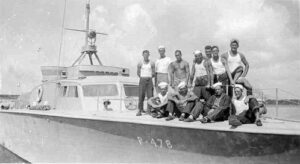
Iwo Jima
Iwo Jima, an island of volcanic rock, is located halfway between Saipan and Japan. In enemy hands, it was an obstacle to B-29 formations en route to Japan, a staging area for enemy aircraft strikes against B-29 bases in the Marianas, and a threat to air-sea rescue operations along the B-29’s flight route. In American hands, it would provide an emergency landing field for B-29s in distress, which previously had to ditch at sea, and a base from which AAF fighters could escort the Superfortresses to Japan.
After weeks of AAF and Navy aerial bombardment and shelling, Marines assaulted Iwo Jima on Feb. 19, 1945. Stubborn enemy troops resisted fanatically, and the island was not secured until late March at a cost of nearly 26,000 American casualties, including 6,800 killed in action. Despite the high cost, the island would prove a haven to more than 24,000 B-29 crewmen whose planes used its emergency landing strips during the remainder of the war.
Based on the search results, there is limited specific information about AVR (Auxiliary Vessel, Rescue) boats and their role in rescuing downed pilots at Iwo Jima during February-March 1945. However, we can piece together some relevant information about air-sea rescue operations during this period:
- Air-sea rescue operations:
- PBM Mariner flying boats were used for “dumbo missions” (air-sea rescue) starting from February 28, 1945.
- These PBMs operated from patrol plane tenders anchored in the lee of Iwo Jima when sea conditions permitted.
- The PBMs used jet-assisted take-off to operate in the challenging sea conditions around Iwo Jima.
- Rescue coordination:
- Fleet Air Wing One (TG 50.5) conducted searches using PB4Y aircraft based on Tinian.
- Once Iwo Jima’s airfield was operational, search sectors were extended by having PB4Ys stage through Iwo for additional fuel.
- Rescue facilities:
- Offshore, some LSTs (Landing Ship, Tank) were converted into barracks ships, providing facilities including sick bays.
- An “evacuation-control LST” (identified by a painted letter H on its hull) was stationed offshore to examine and process casualties.
- B-29 emergency landings:
- As early as March 4, 1945, while fighting was still ongoing, a B-29 made an emergency landing on the Allied-controlled section of Iwo Jima’s South Field.
- Throughout the war, 2,251 B-29 landings were recorded on Iwo Jima, though not all were for genuine emergencies.
- Rescue impact:
- Some downed B-29 crewmen were saved by air-sea rescue aircraft and AVRs operating from the island.
- However, the capture of Iwo Jima did not completely eliminate the need for a comprehensive air-sea rescue program along the B-29 route to Japan.
Regarding AVRs specifically:
- The search results do not provide information about where AVRs were stationed or their specific role in rescuing downed pilots at Iwo Jima.
- The results focus more on larger vessels and aircraft involved in rescue operations.
To get more specific information about AVR boats and their role in rescuing downed pilots at Iwo Jima, we would need additional sources that focus on smaller rescue craft operations during this battle. The available information suggests that air-sea rescue was a significant concern, but the specific contribution of AVRs to these efforts is not detailed in these search results.
Sources
[1] Amphibious Operations: Capture of Iwo Jima
[2] The Battle of Iwo Jima—A Sailor’s View https://www.history.navy.mil/browse-by-topic/wars-conflicts-and-operations/world-war-ii/1945/battle-of-iwo-jima/iwo-jima-sailors-view.html
[3] Battle of Iwo Jima – Wikipedia https://en.wikipedia.org/wiki/Battle_of_Iwo_Jima
[4] Ryukyus > National Museum of the United States Air Force™ > Display https://www.nationalmuseum.af.mil/Visit/Museum-Exhibits/Fact-Sheets/Display/Article/196199/ryukyus/
Submarine chasers
As mentioned previously, the US Coast Guard added supchasers to its AVR fleet. In the context of U.S. Coast Guard and postwar vessel designations, WAVR is commonly understood to stand for “Wooden-hull Aviation Rescue” vessel. These were wooden boats, often former subchasers or patrol craft, repurposed for aviation rescue duties.
Of the 438 SC-497 class vessels built, remarkably few have survived to the present day. The search results indicate that only one is officially preserved: HNoMS Hitra (formerly USS SC-718), which is maintained at the Royal Norwegian Navy Museum as a tribute to Norway’s naval contributions during World War II.
The SC-1068/Air Snipe survived as a privately owned yacht , representing another rare survivor of this numerous but largely forgotten class. Production began in 1941 and continued through 1944.
These versatile wooden vessels fulfilled critical patrol, escort, and rescue roles during World War II and continued to serve in various capacities long after the conflict ended. Their wooden construction and moderate size made them easy to modify while suitable for coastal operations, though they could also venture further offshore when required. Despite their submarine chaser designation and widespread deployment, none of the SC-497 class vessels are officially credited with destroying an enemy submarine or ship.
Their widespread distribution through the Lend-Lease program further enhanced their historical significance, as these American-built vessels served under multiple flags and participated in diverse operations across the world’s oceans.
The conversion of many SC-497 class vessels to alternative roles, including SC-1068’s transformation into the Coast Guard rescue vessel Air Snipe, demonstrates their adaptability and practical design.
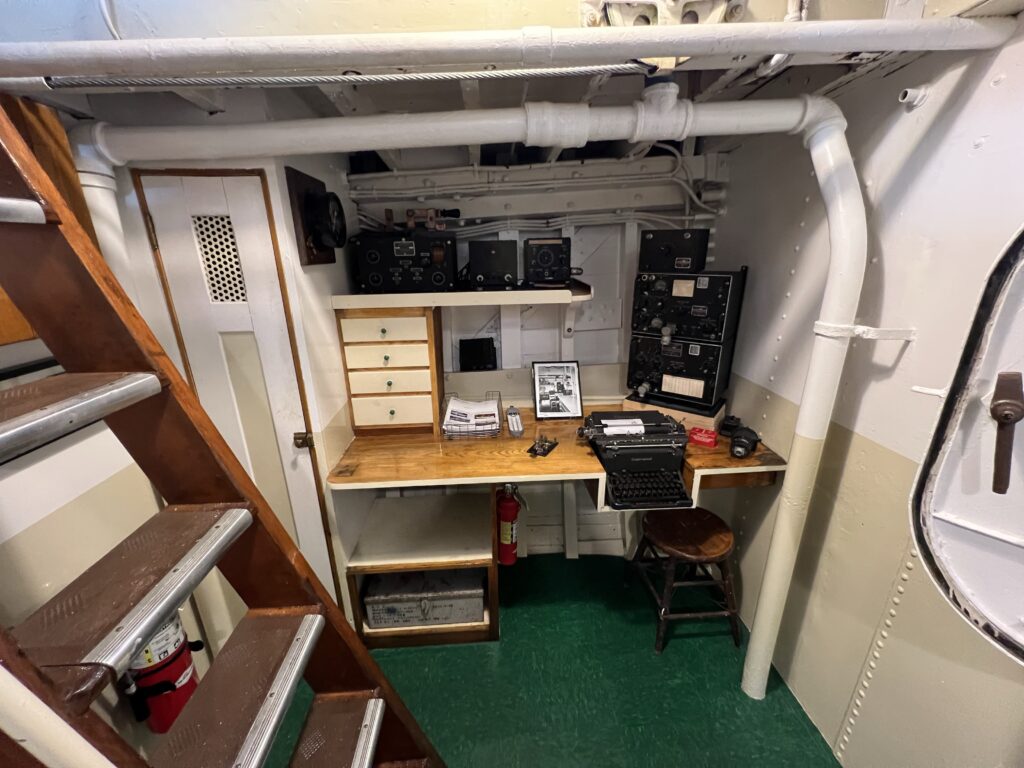
438 SC-497 (originally PC-497) class subchasers were constructed for the USN during WWII to hunt submarines, provide convoy escort, search and rescue services, and provide beach control services for various amphibious invasions. SC-1068 was originally sent to Dutch Harbor AK via the Panama Canal in 1943, She operated along the Aleutian chain out to Kiska and Attu during the clearing of the islands. She was then sent to the South Pacific where she received a battle star for the Invasion of Kwajalein and Majuro. She also ranged out to Guam, Saipan, and Eniwetok.
After WWII ended she was returned to the states and spent two years with the USCG as an Air/Sea Rescue Cutter (this is where she gained the AIR SNIPE name (WAVR-465) – all 70 Cutters were named for birds with the Air prefix).
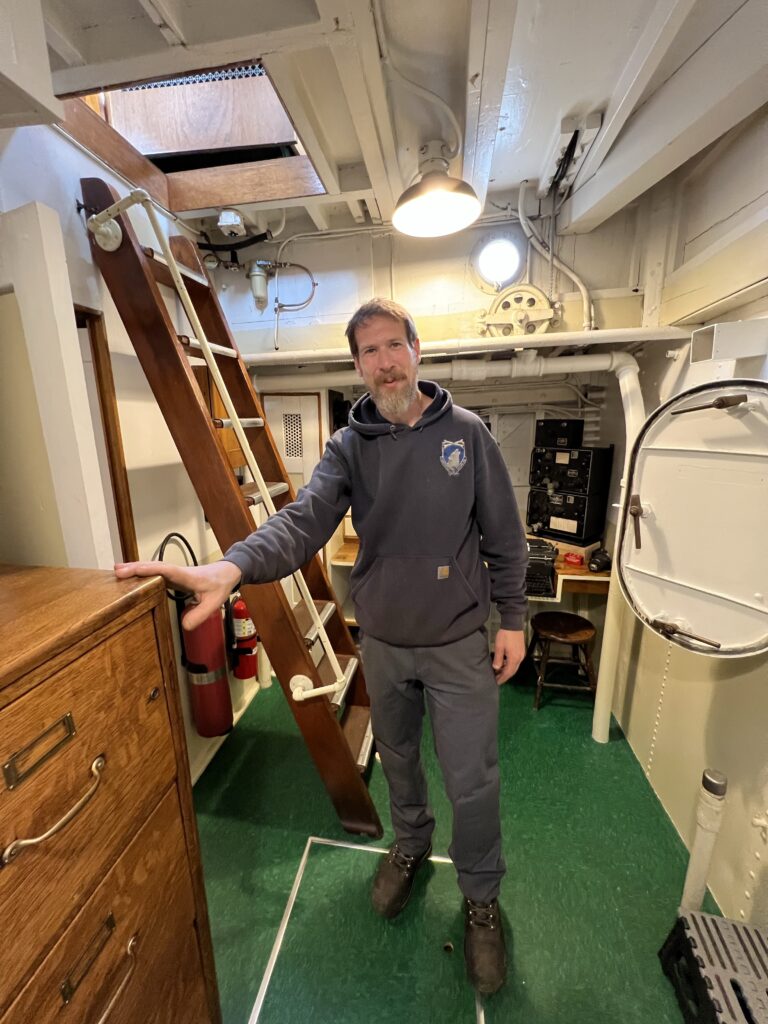
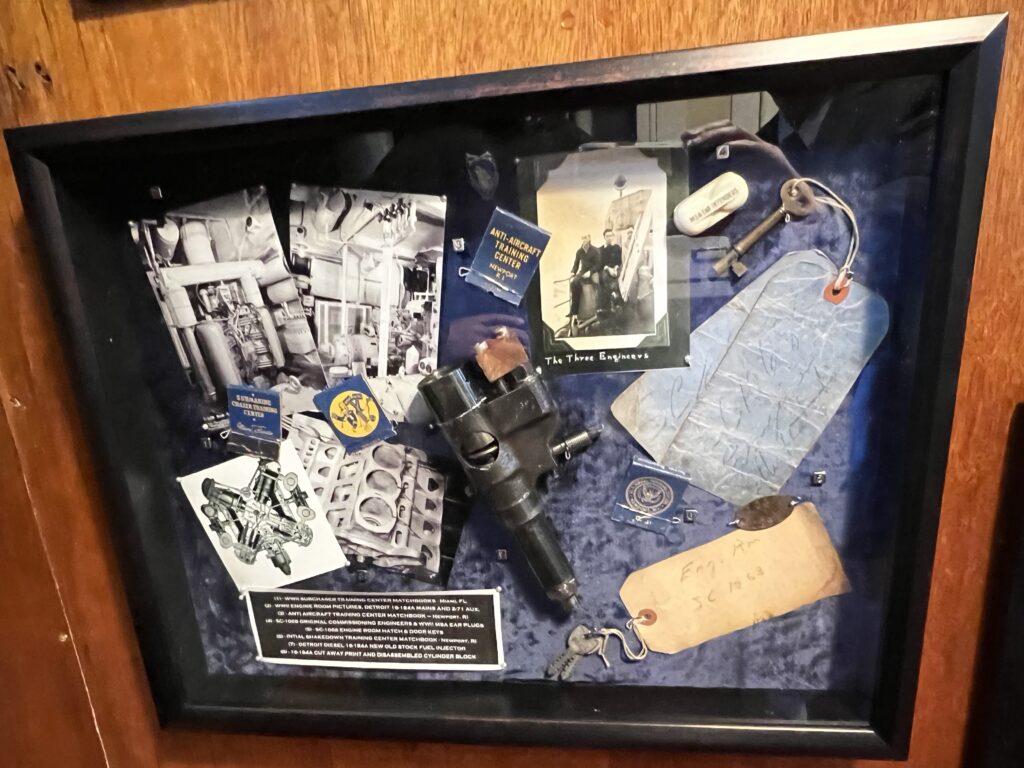
(5) – initial shakedown training center matchbook (6) training school patch (7) Detroit Diesel stock fuel injector (8) cut away print and disassembled cylinder block
In 1948 she was sold privately and passed through several owners before being purchased by Albert (Boyer) Halvorsen in 1954. By 1958 she was in full operation as a commercial tug making trips between Seattle / Pt Madison and SE Alaska. She served as a tug well into the 1990’s when finally phased from commercial service and was restored to be the Halvorsen Family Yacht.
IBID
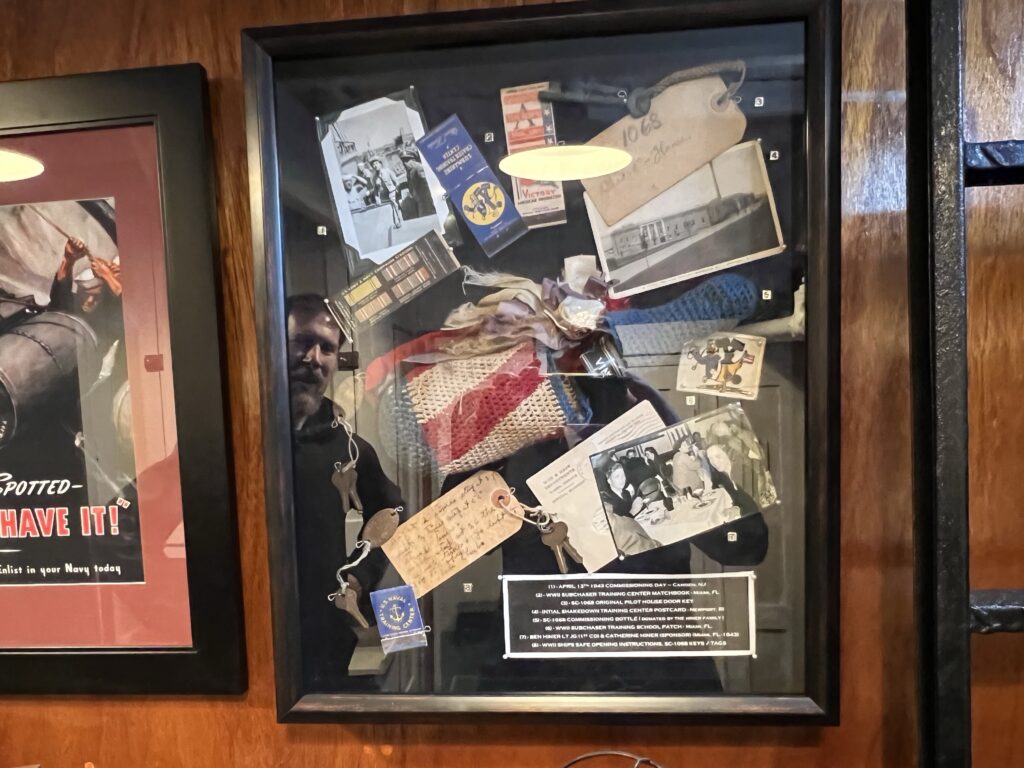
2 – WWII SUBCHASER TRAINING CENTER MATCHBOOK • MIAMI, FL 3 – SC-1068 ORIGINAL PILOT HOUSE DOOR KEY
4 – INTIAL SHAKEDOWN TRAINING CENTER POSTCARD • NEWPORT, RI 5 – SC-1068 COMMISSIONING BOTTLE (DONATED BY THE HINER FAMILY) 6 – WWII SUBCHASER TRAINING SCHOOL PATCH – MIAMI. FL 7 – BEN HINER LT JG (1ST CO) & CATHERINE HINER (SPONSOR) (MIAMI, FL-1943) 8 – WWII SHIPS SAFE OPENING INSTRUCTIONS, SC-1068 KEYS / TAGS
